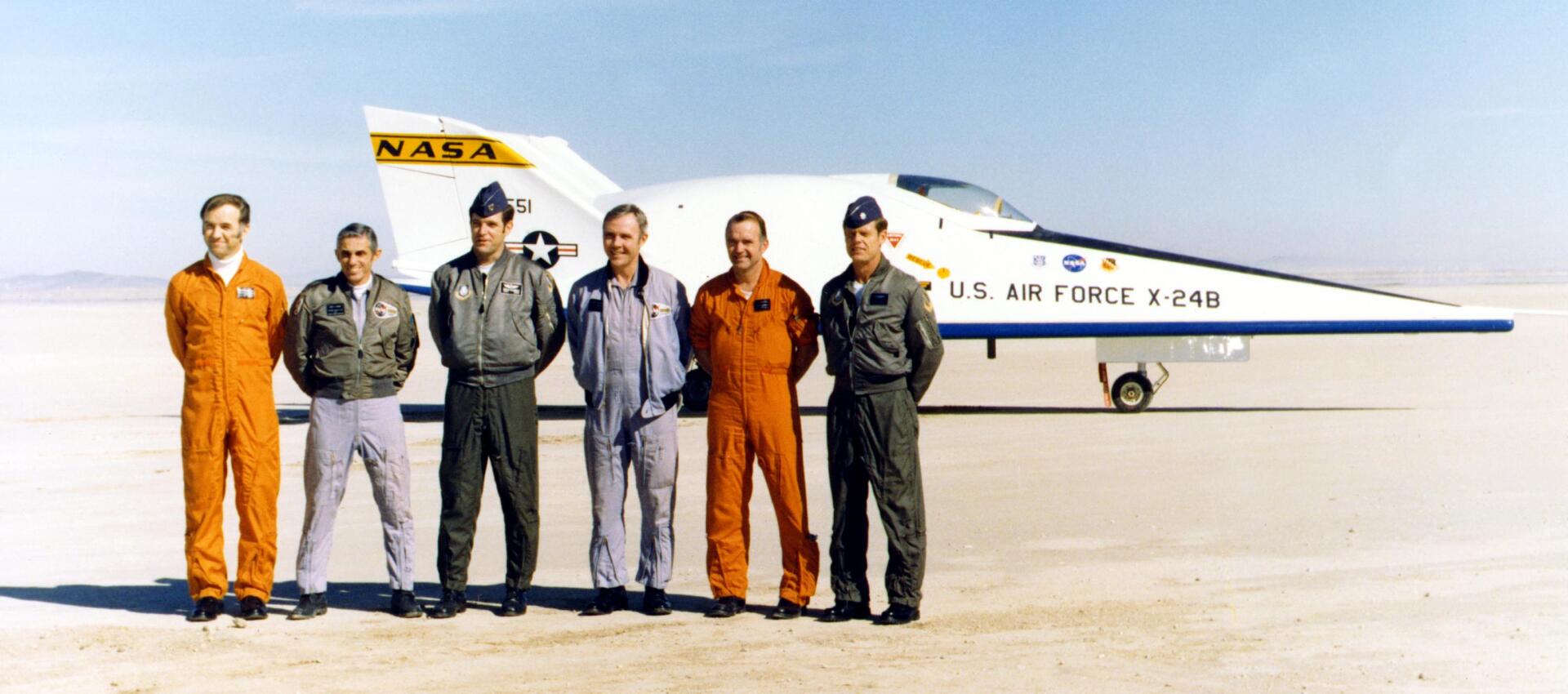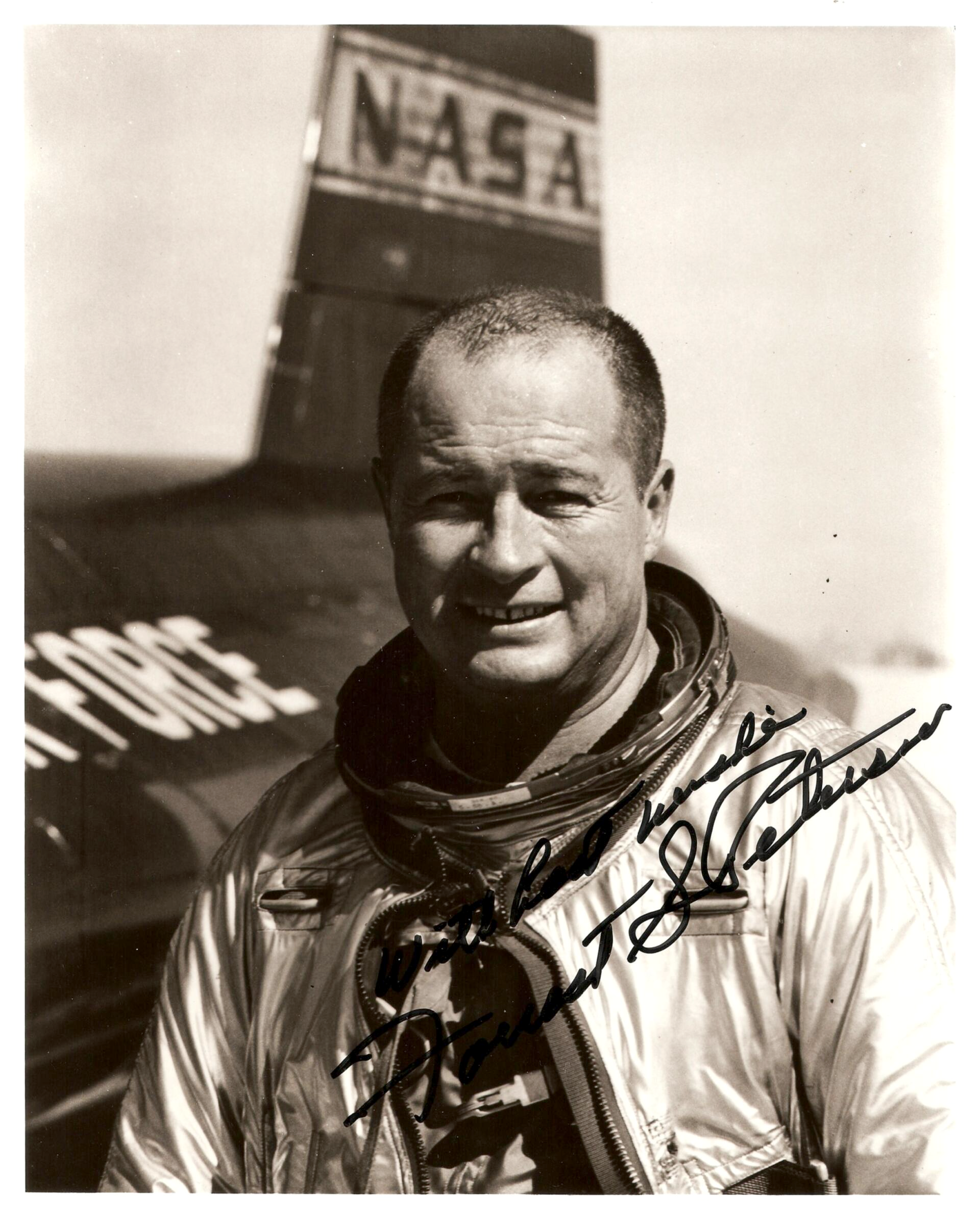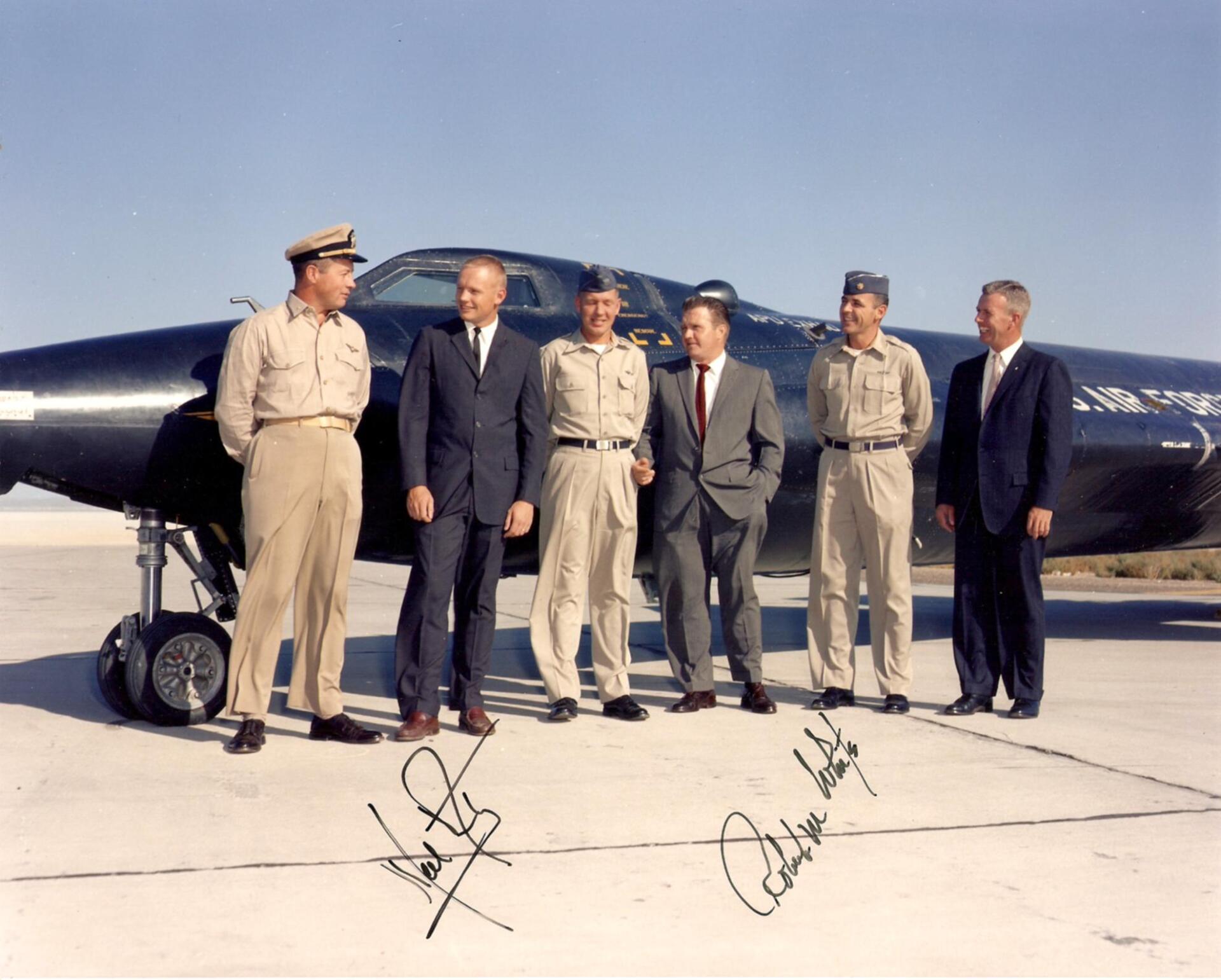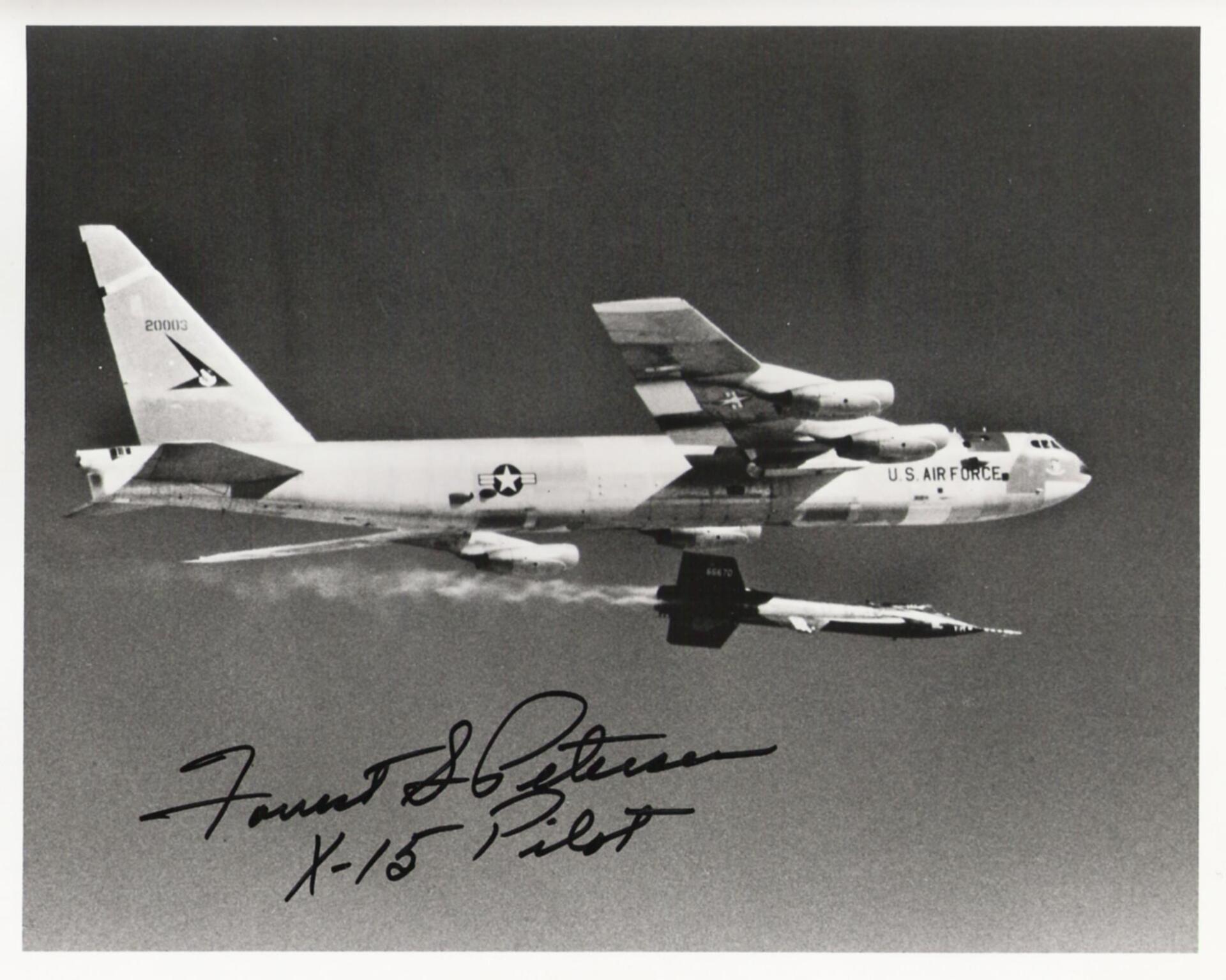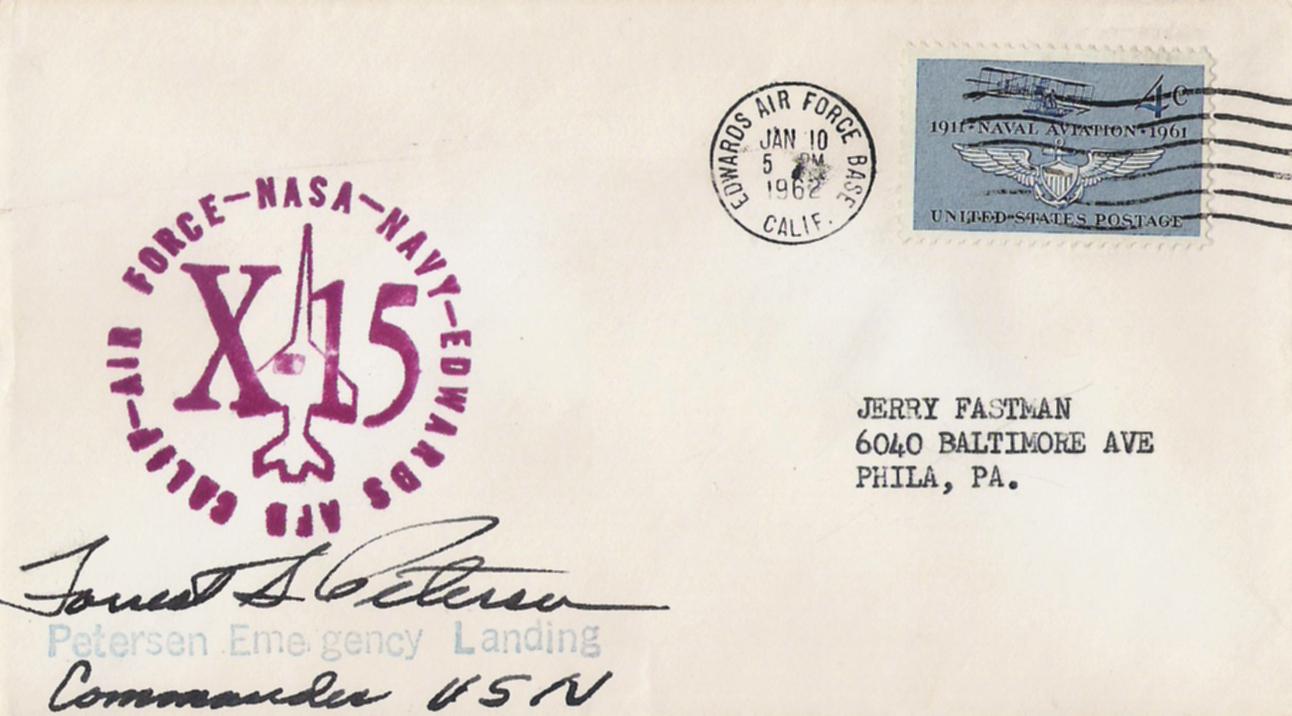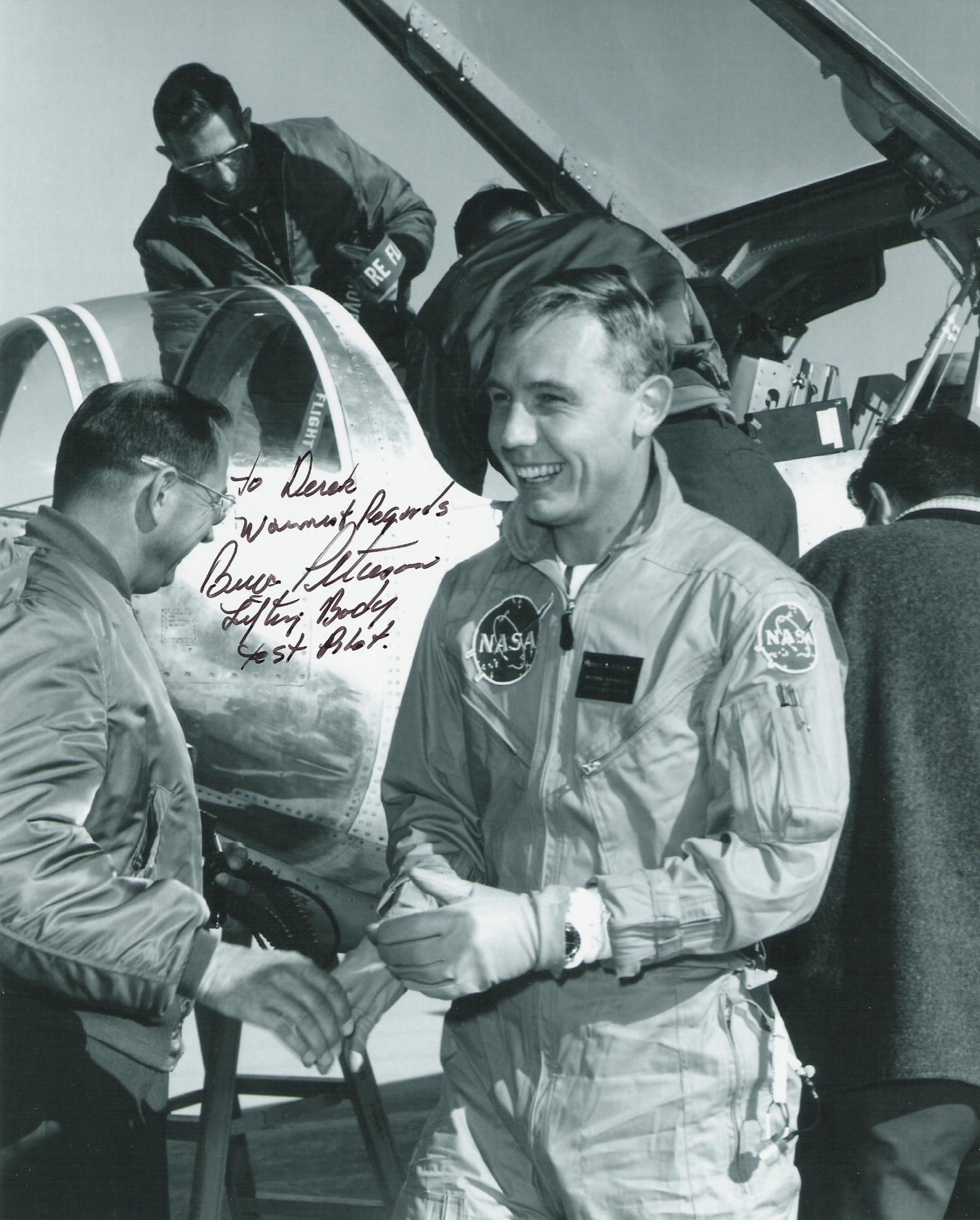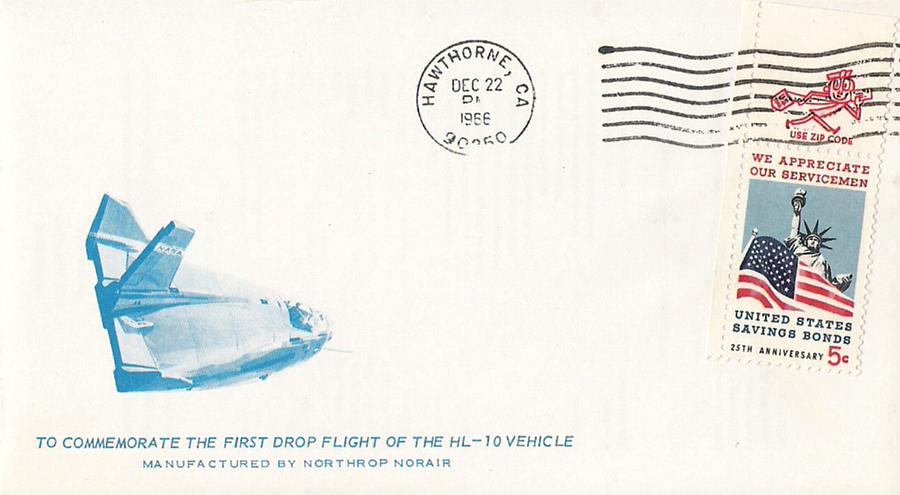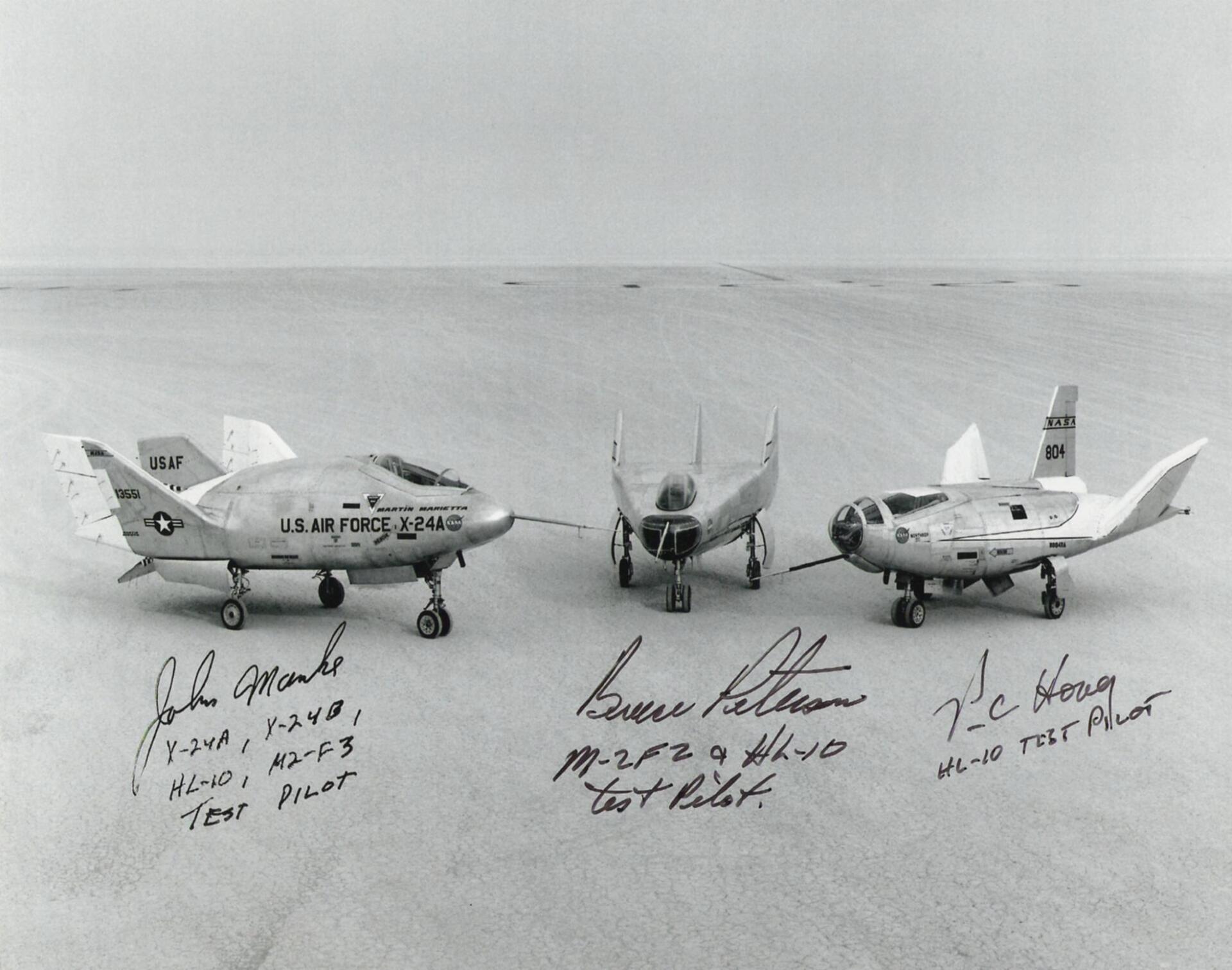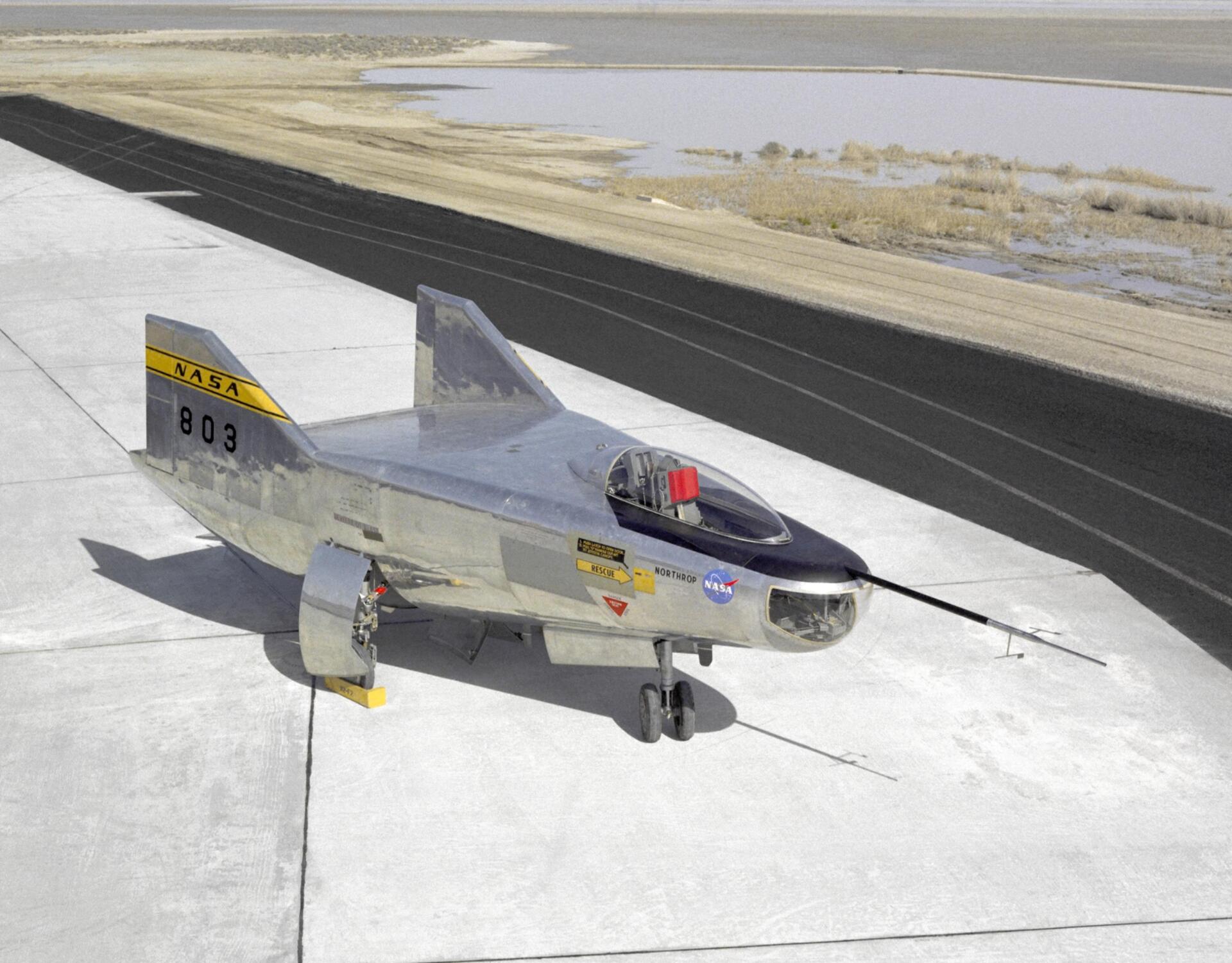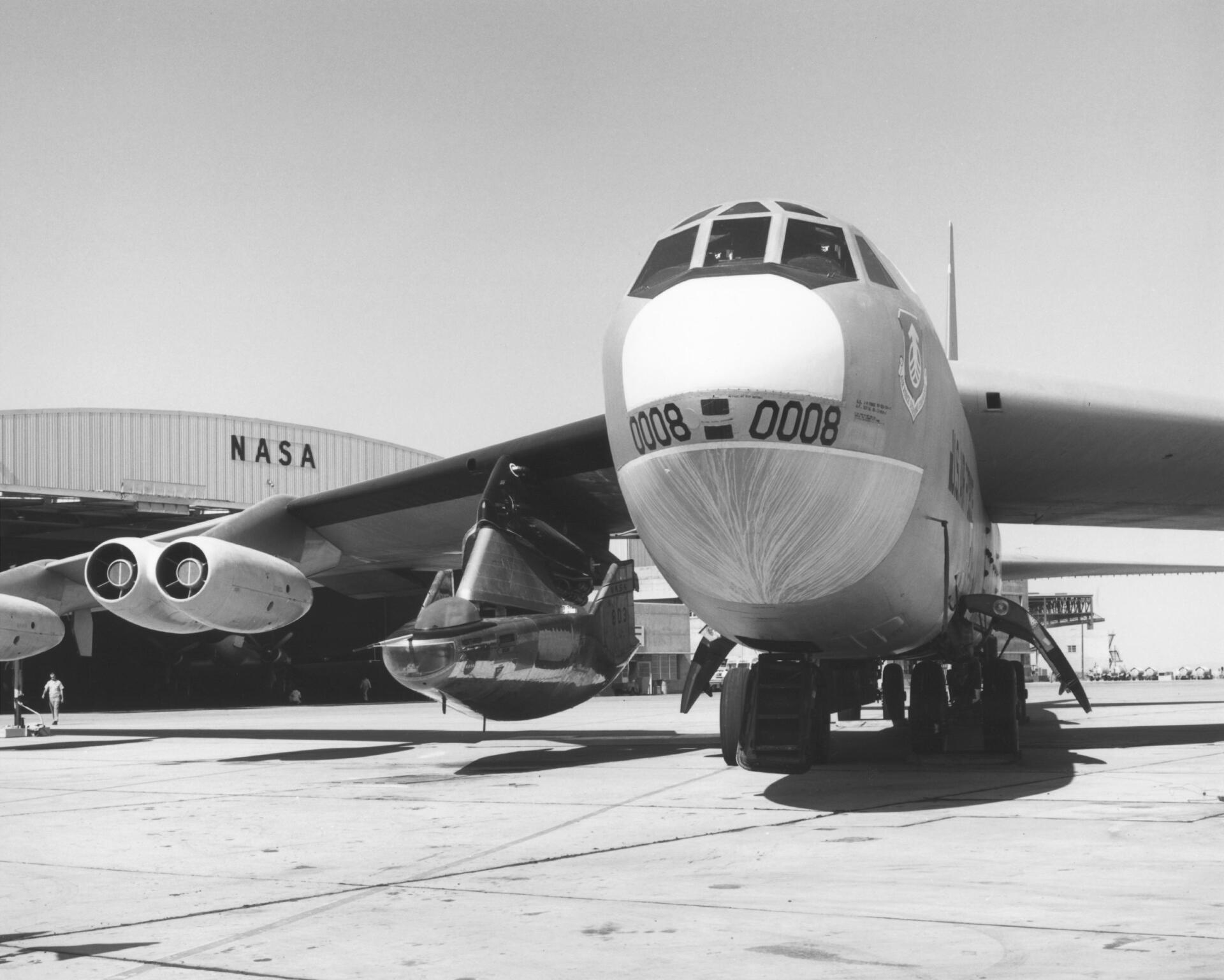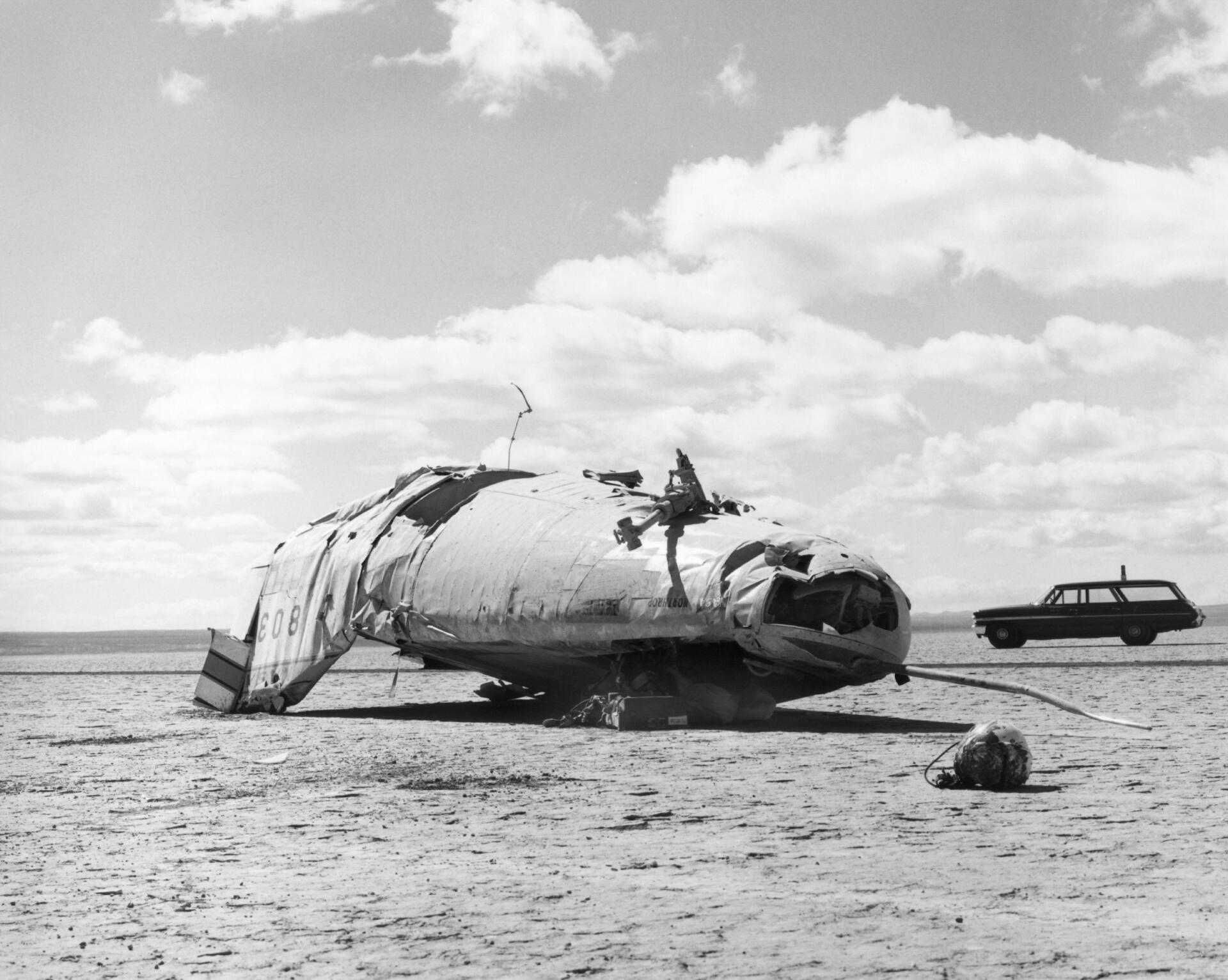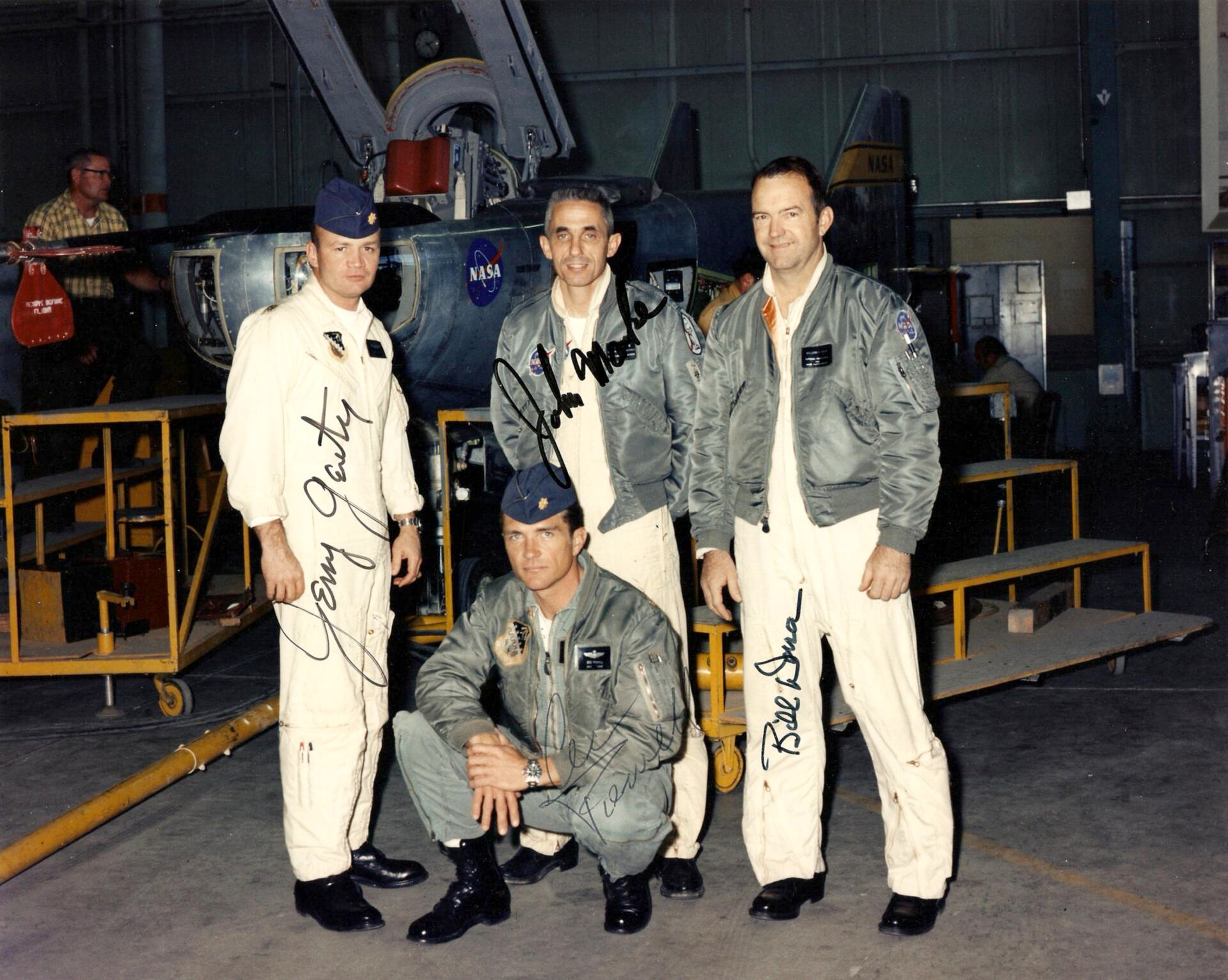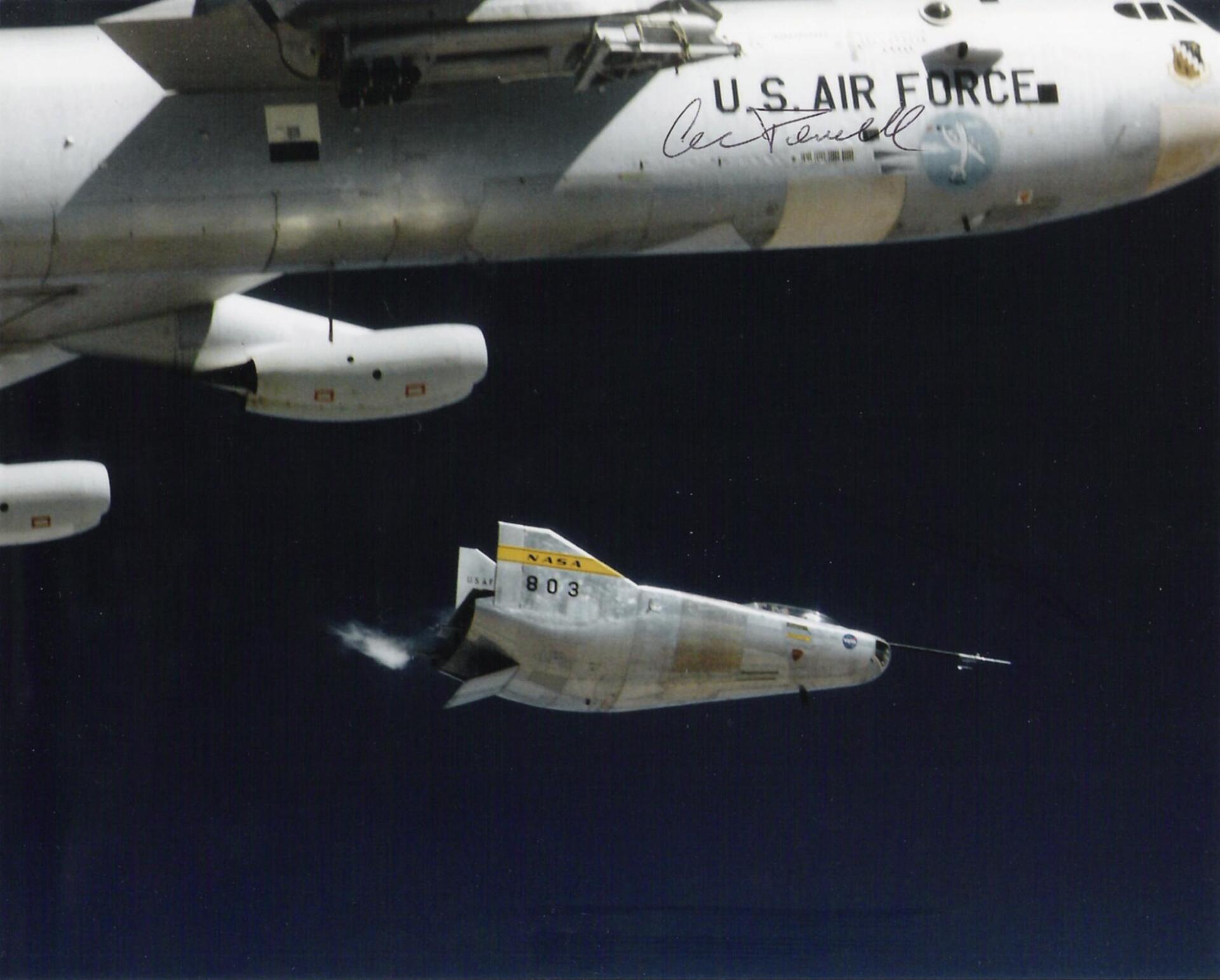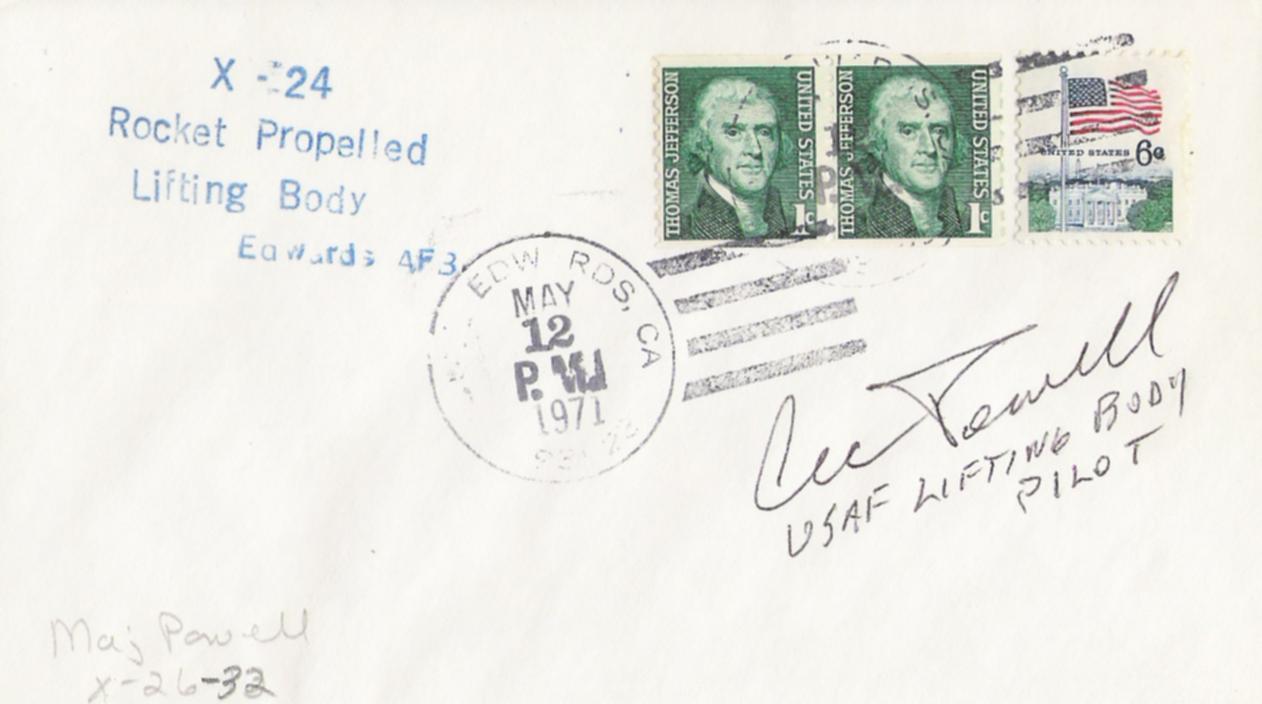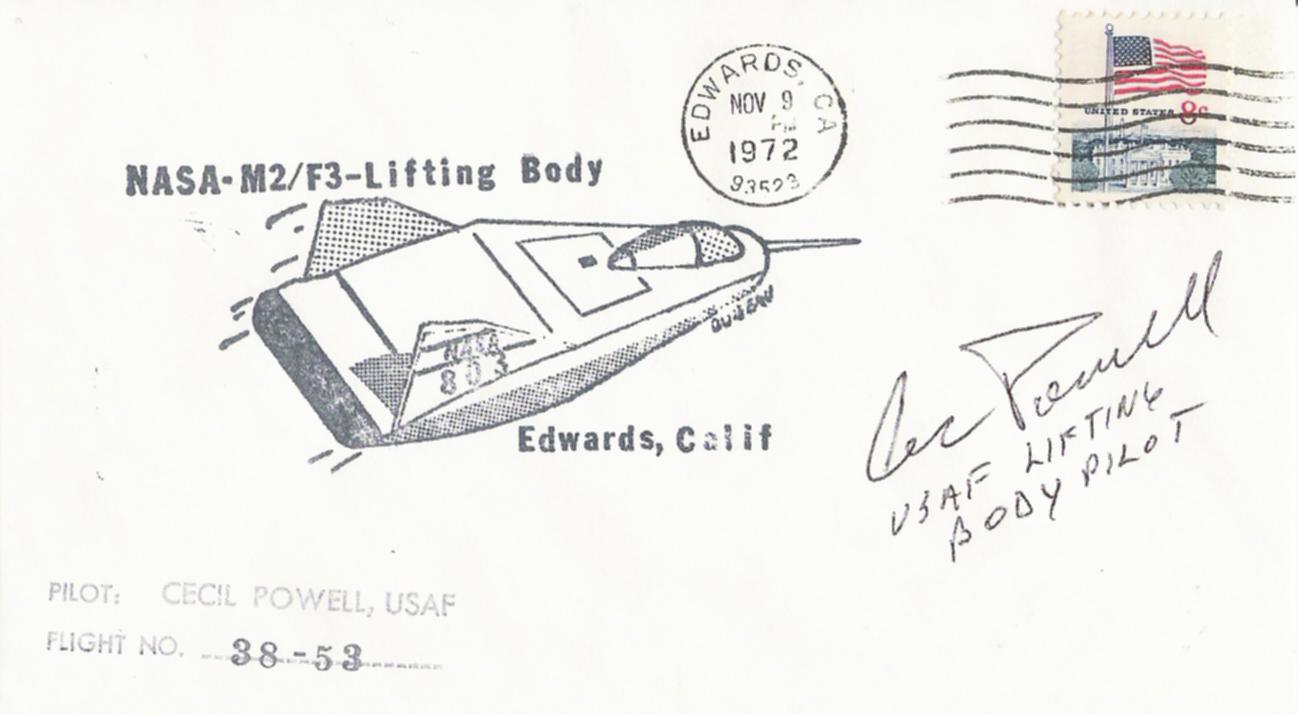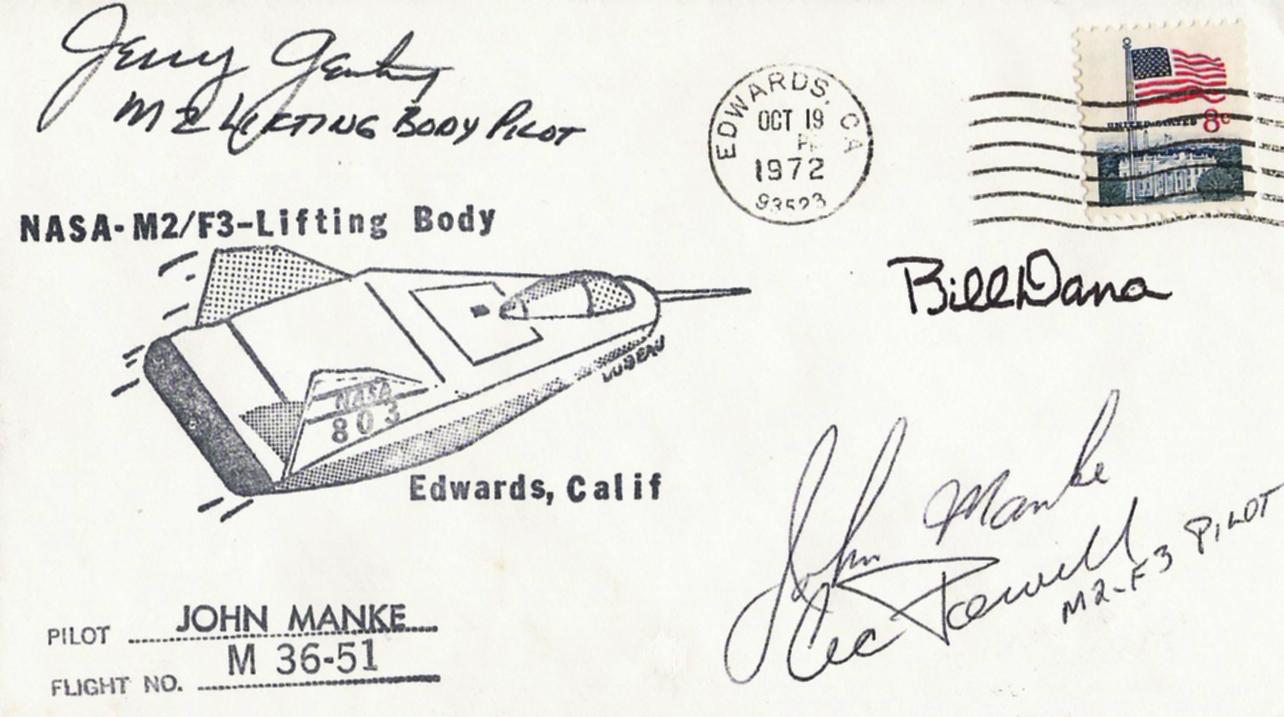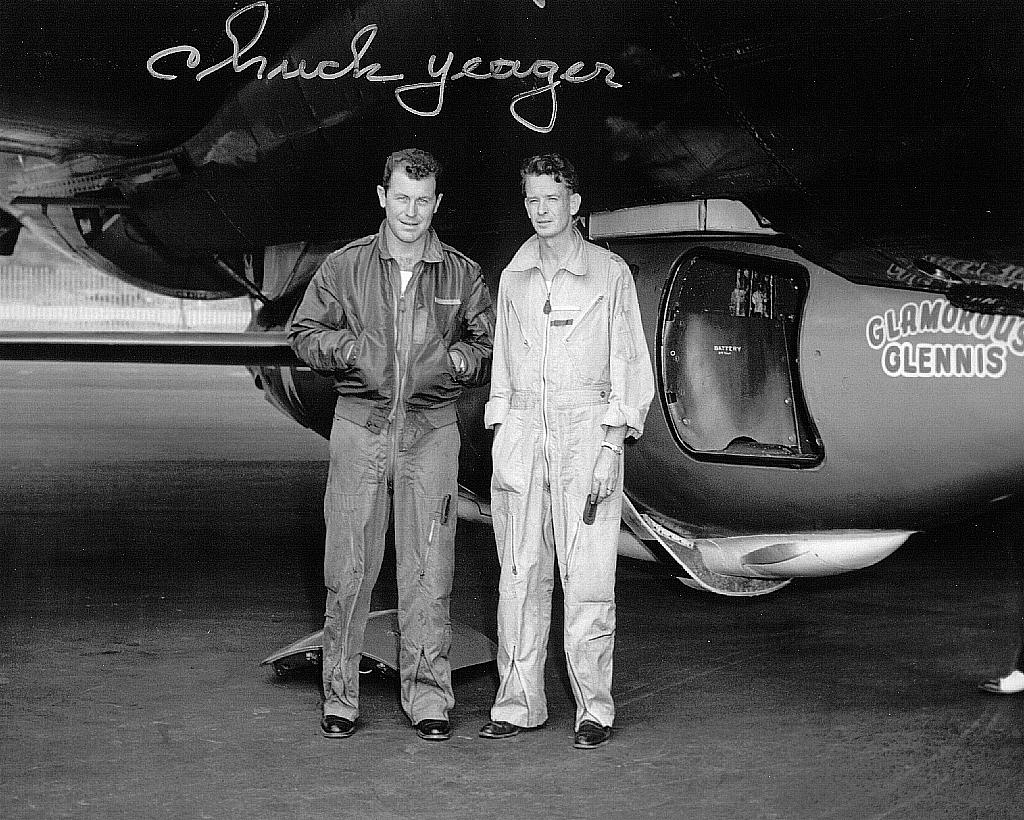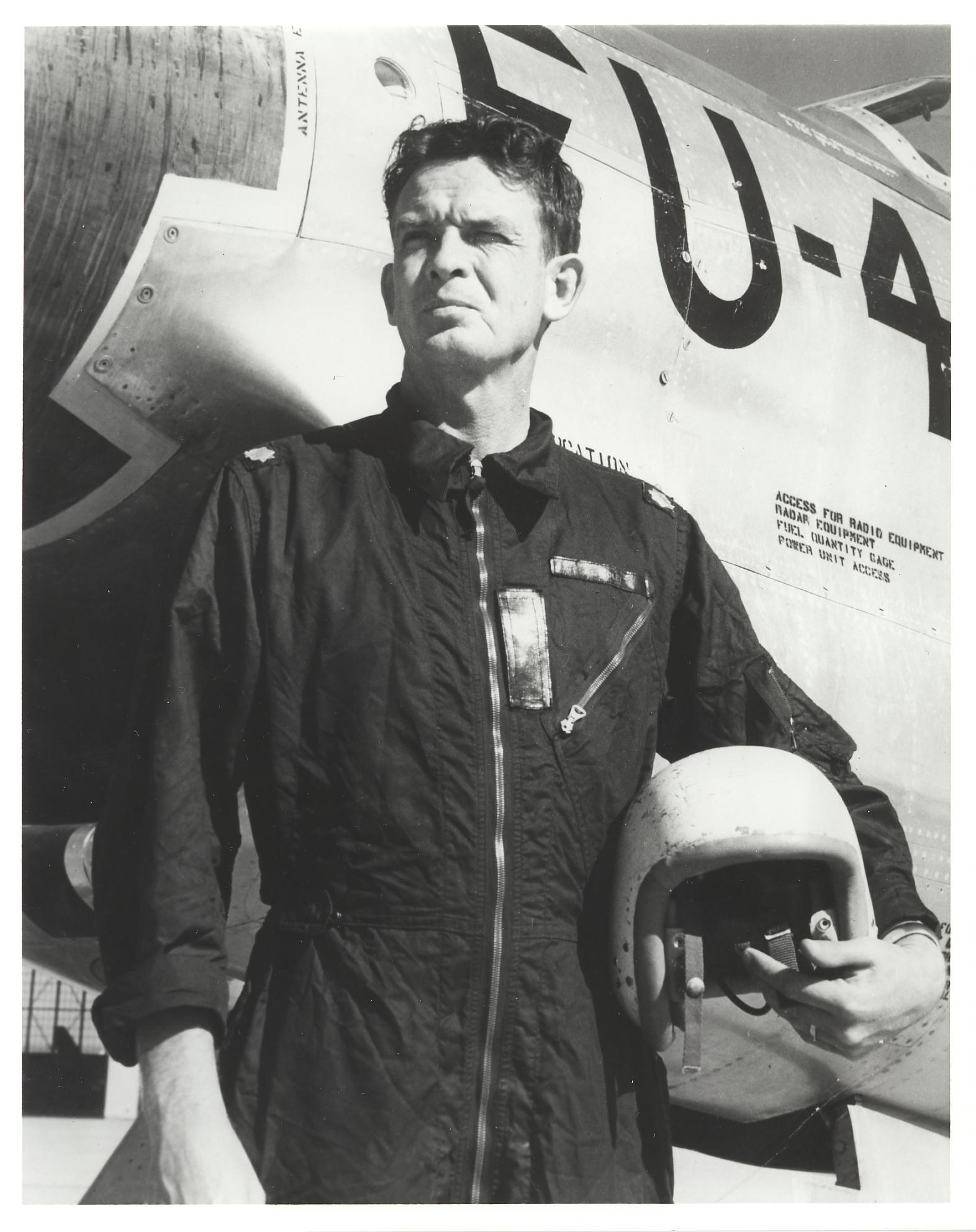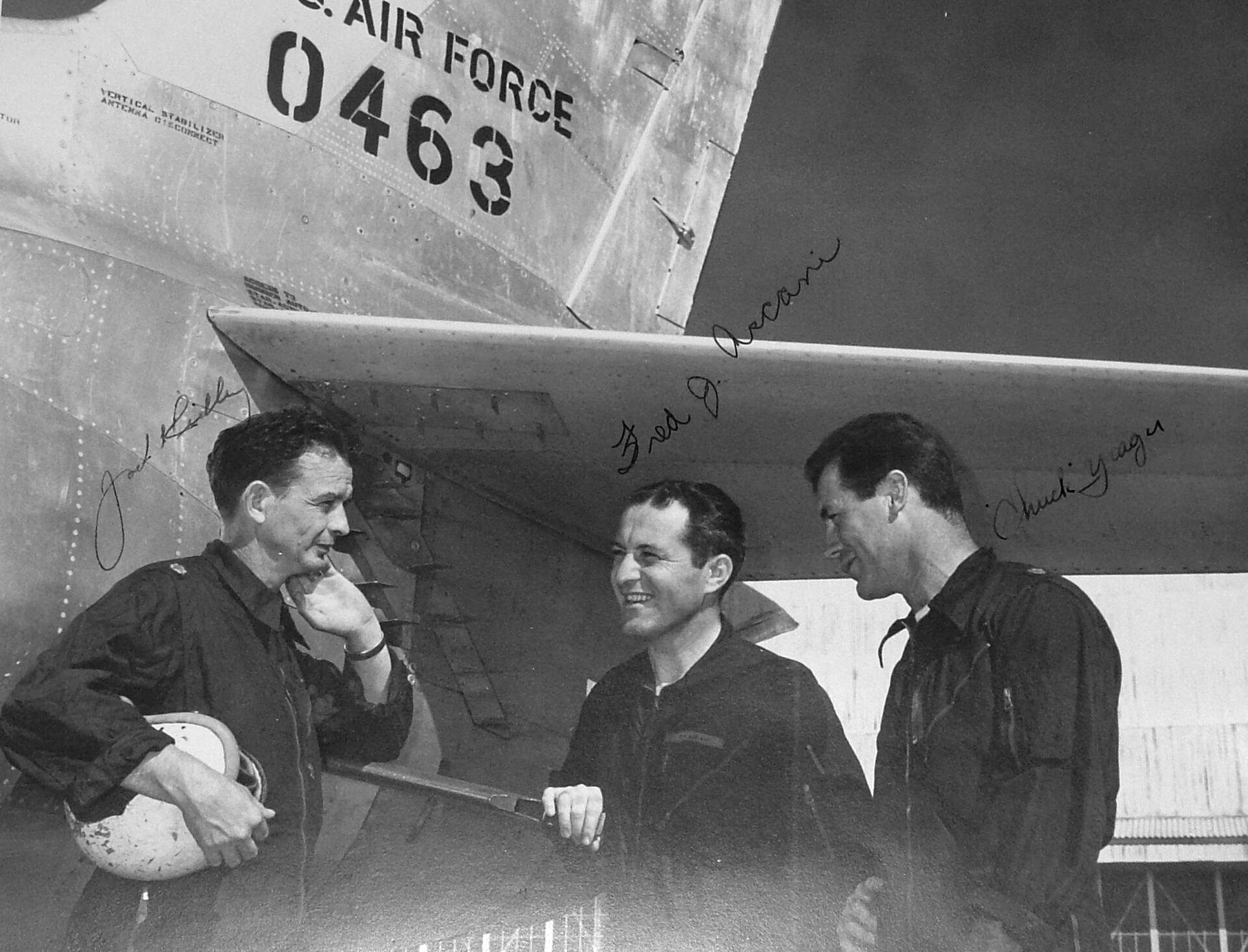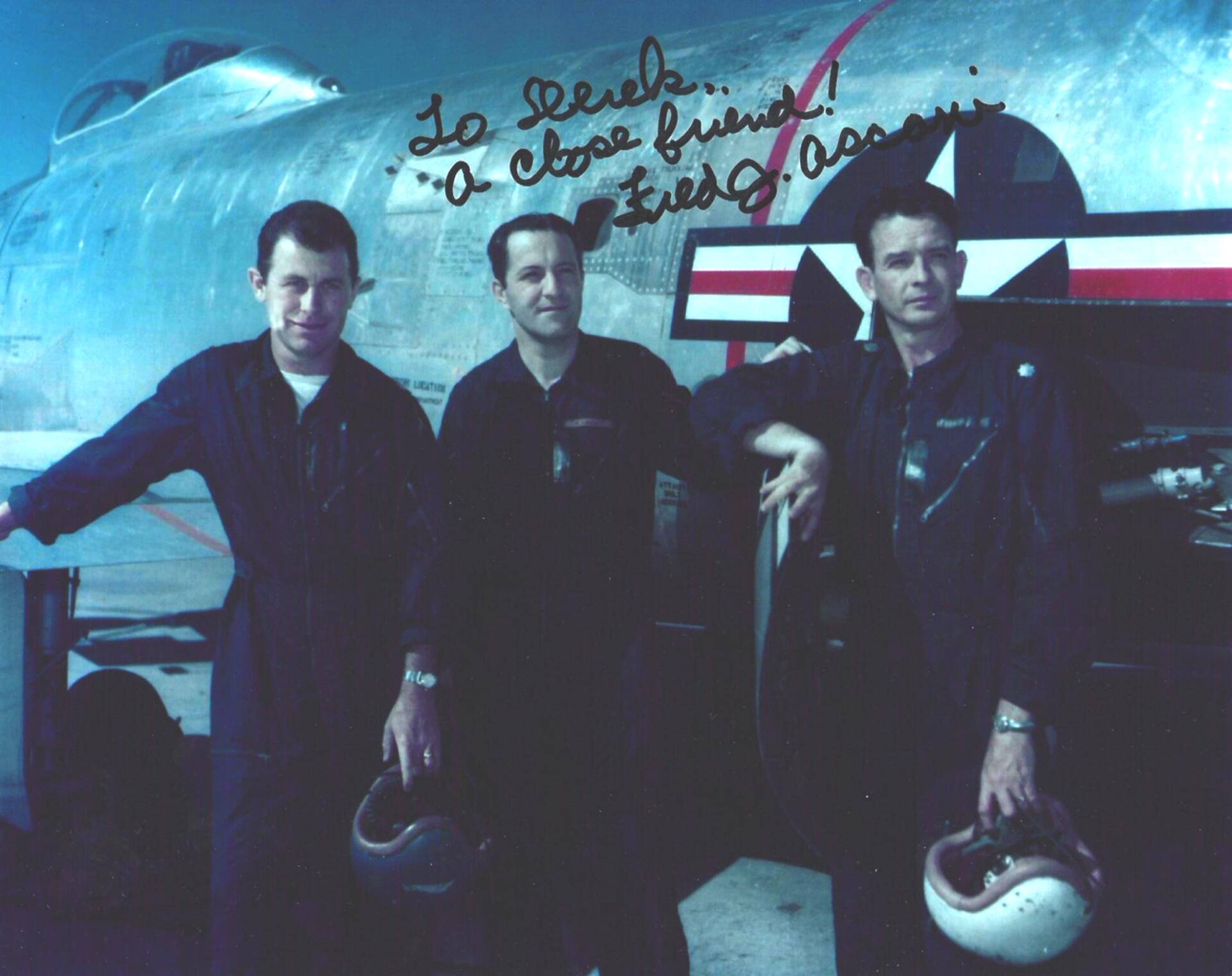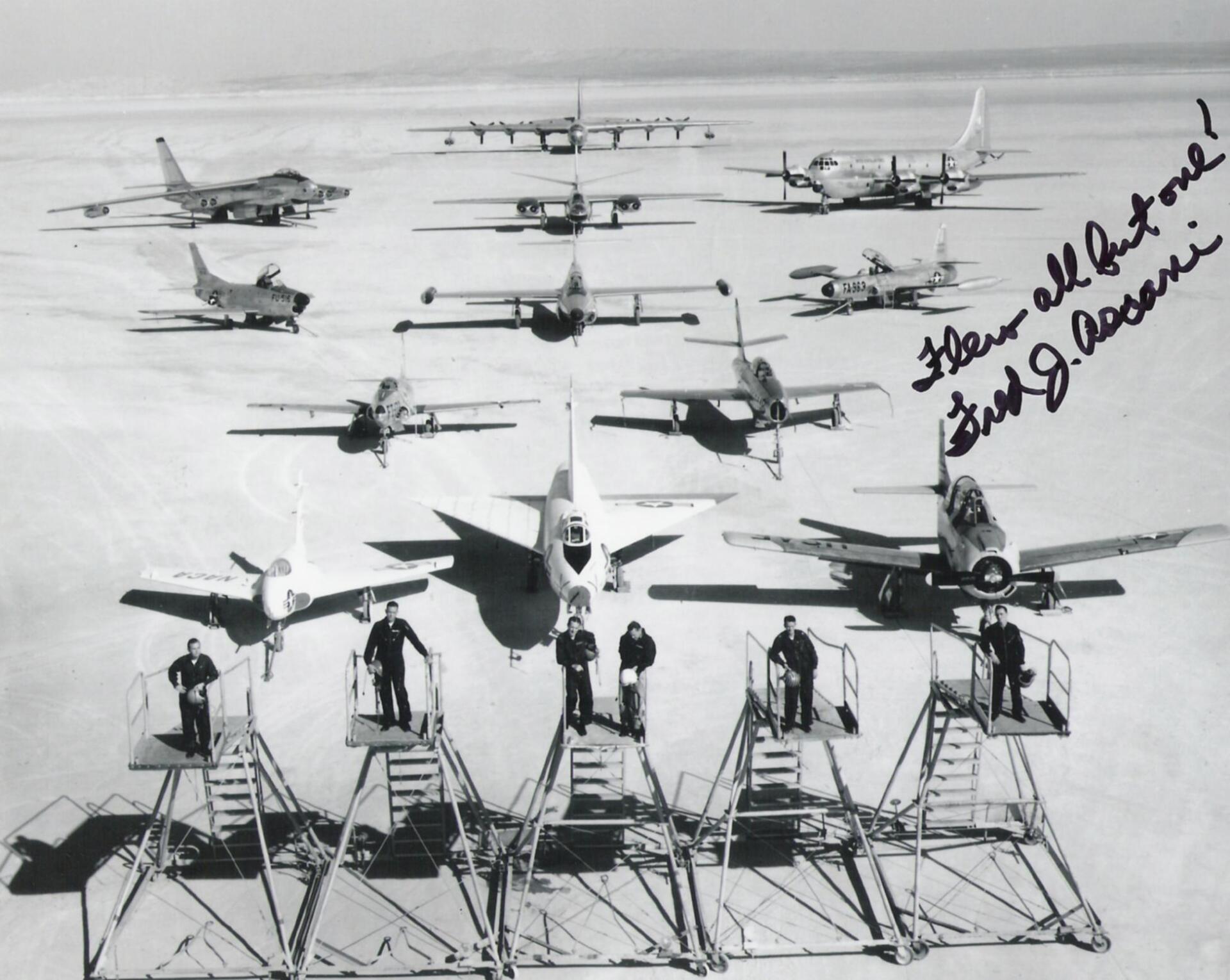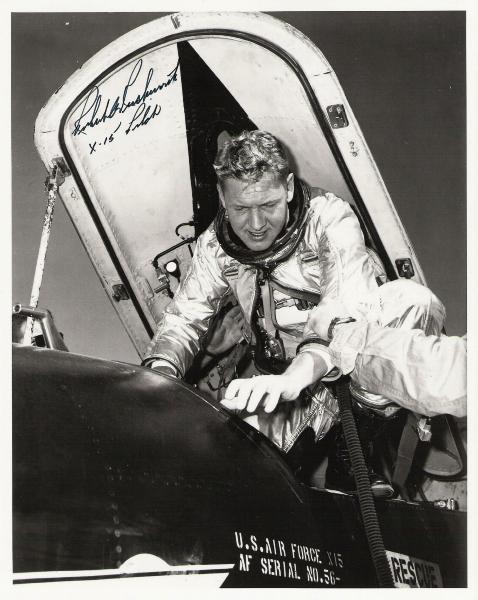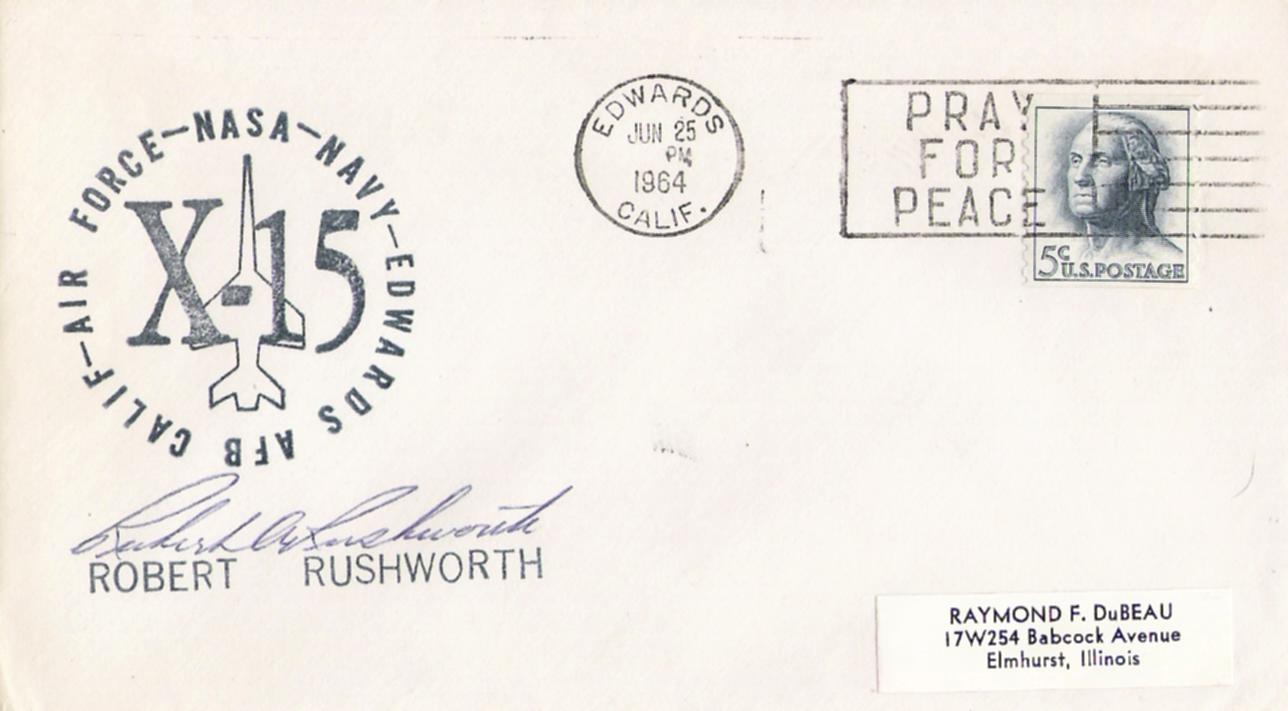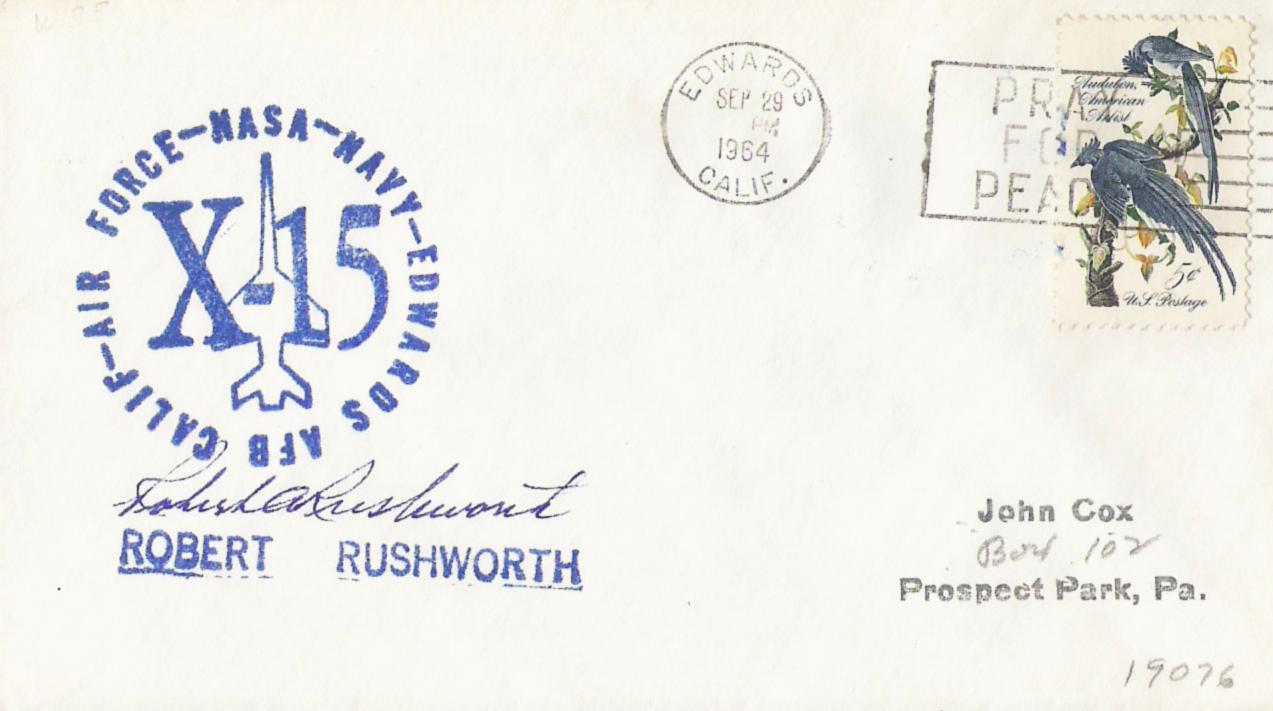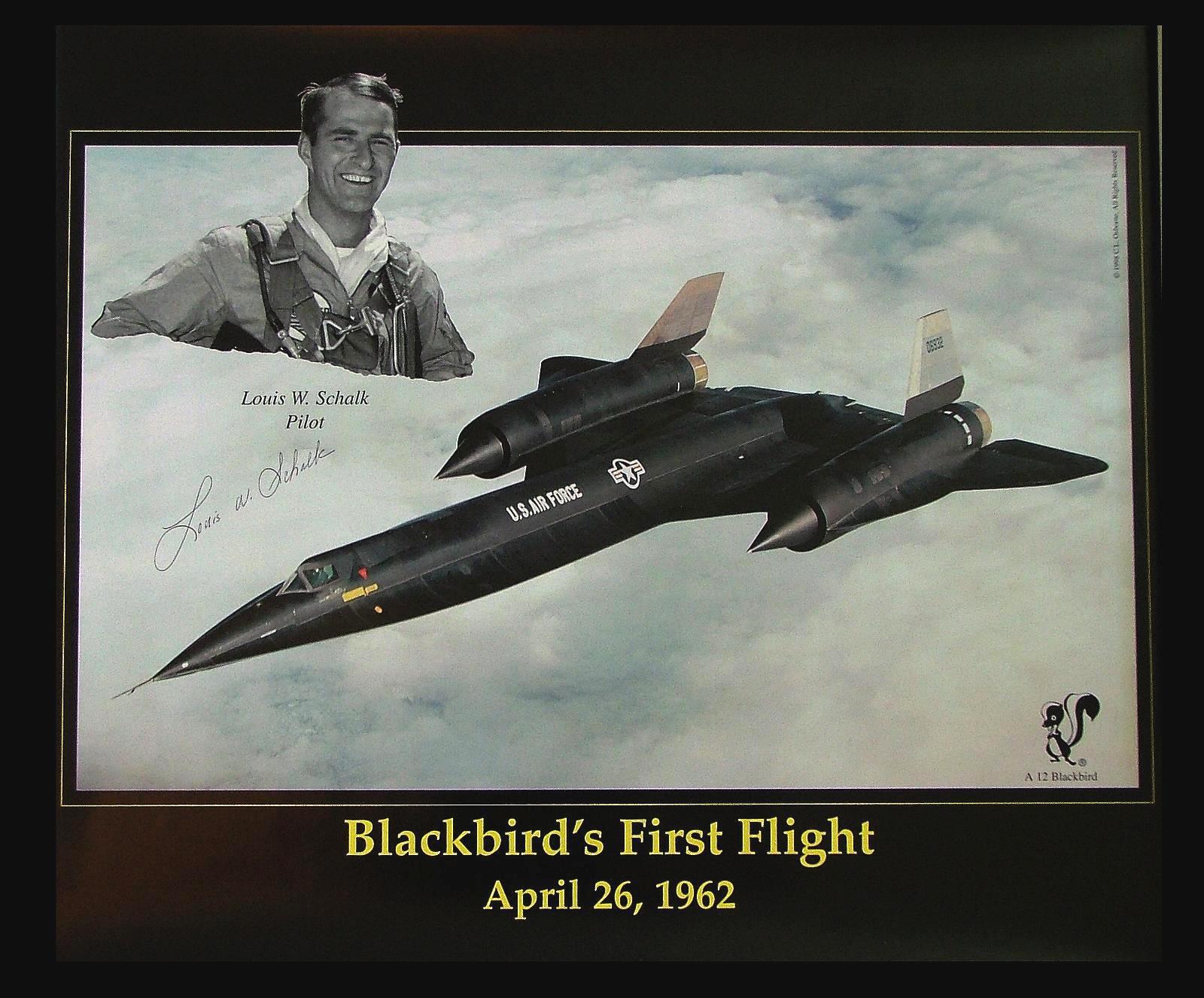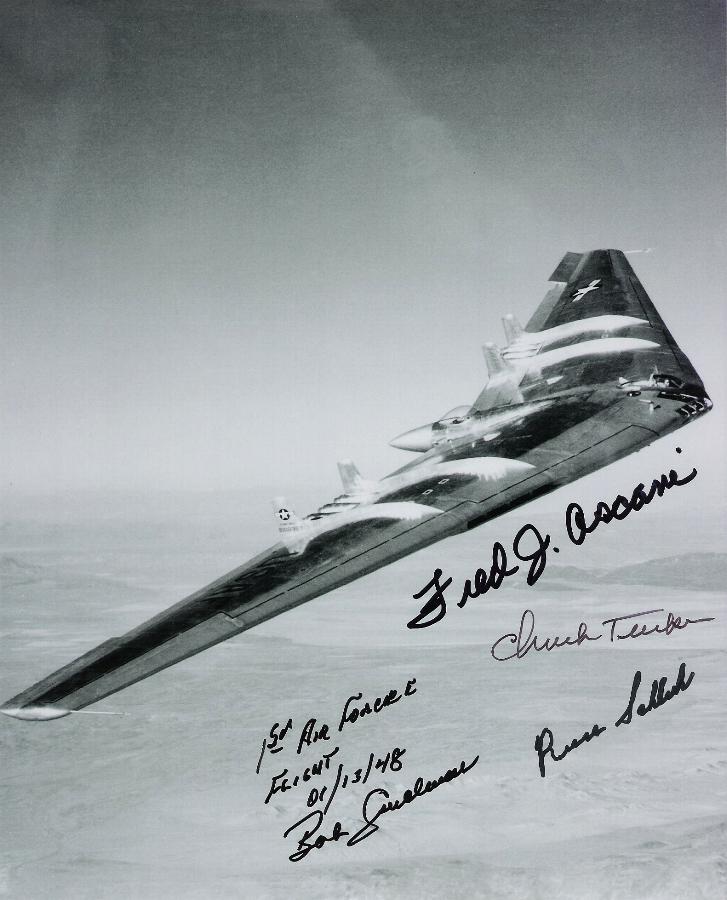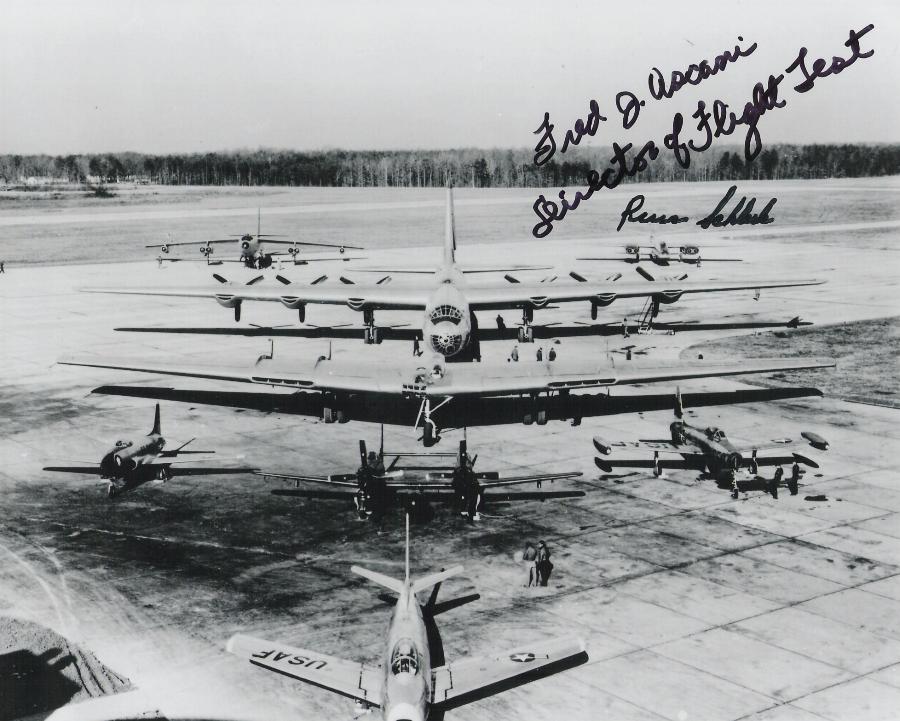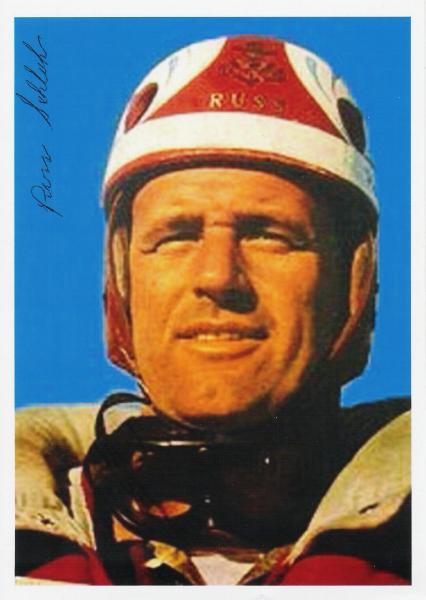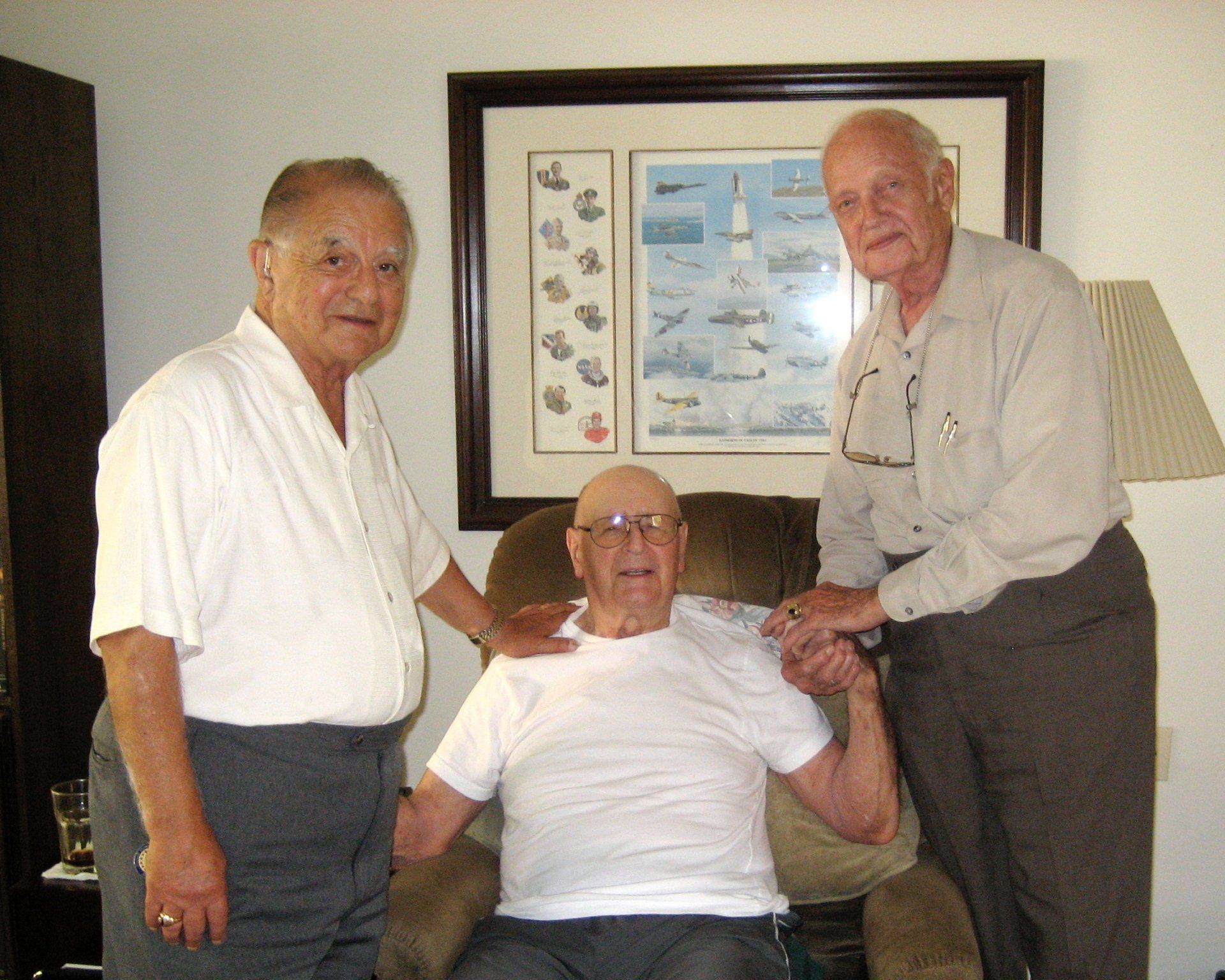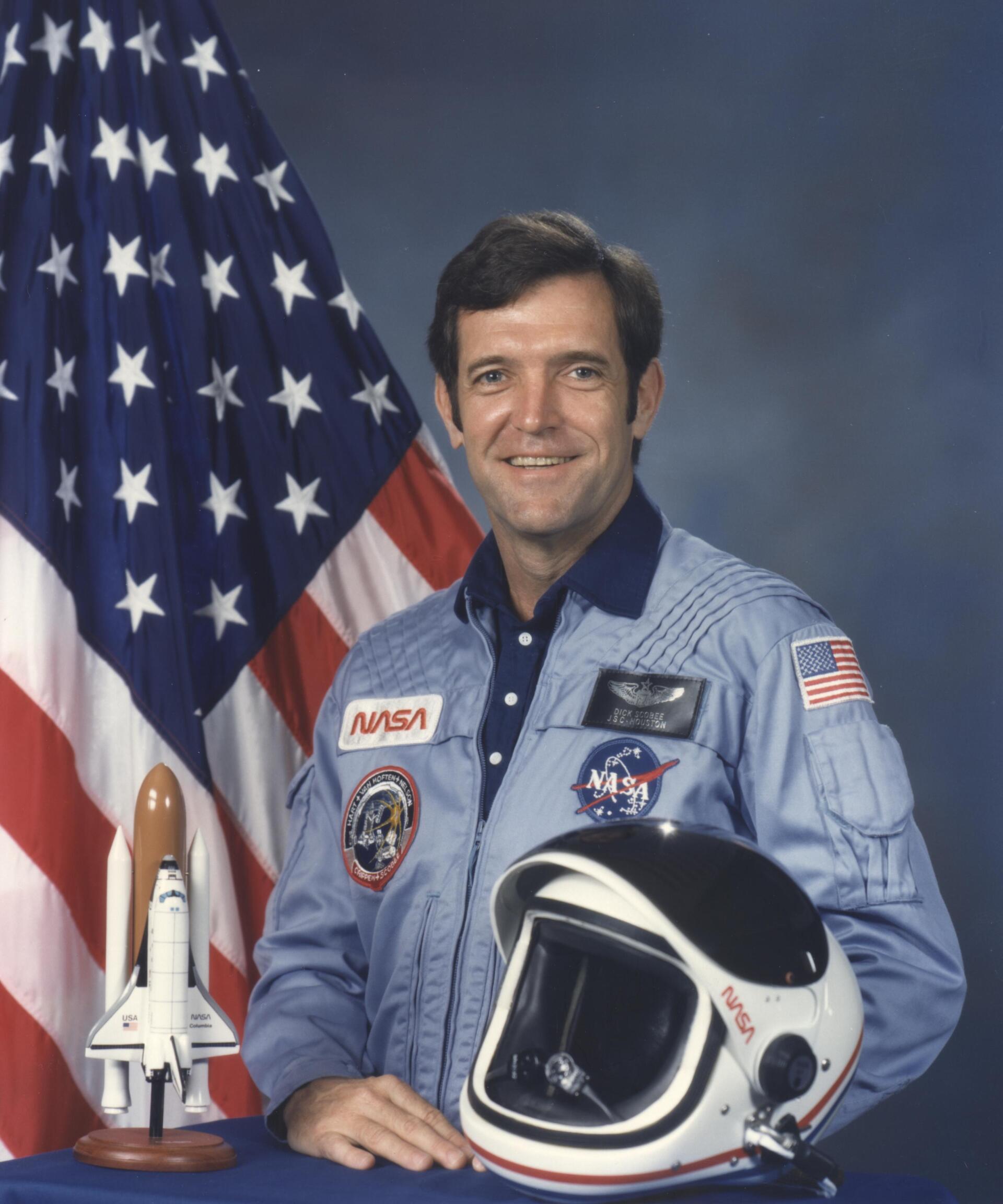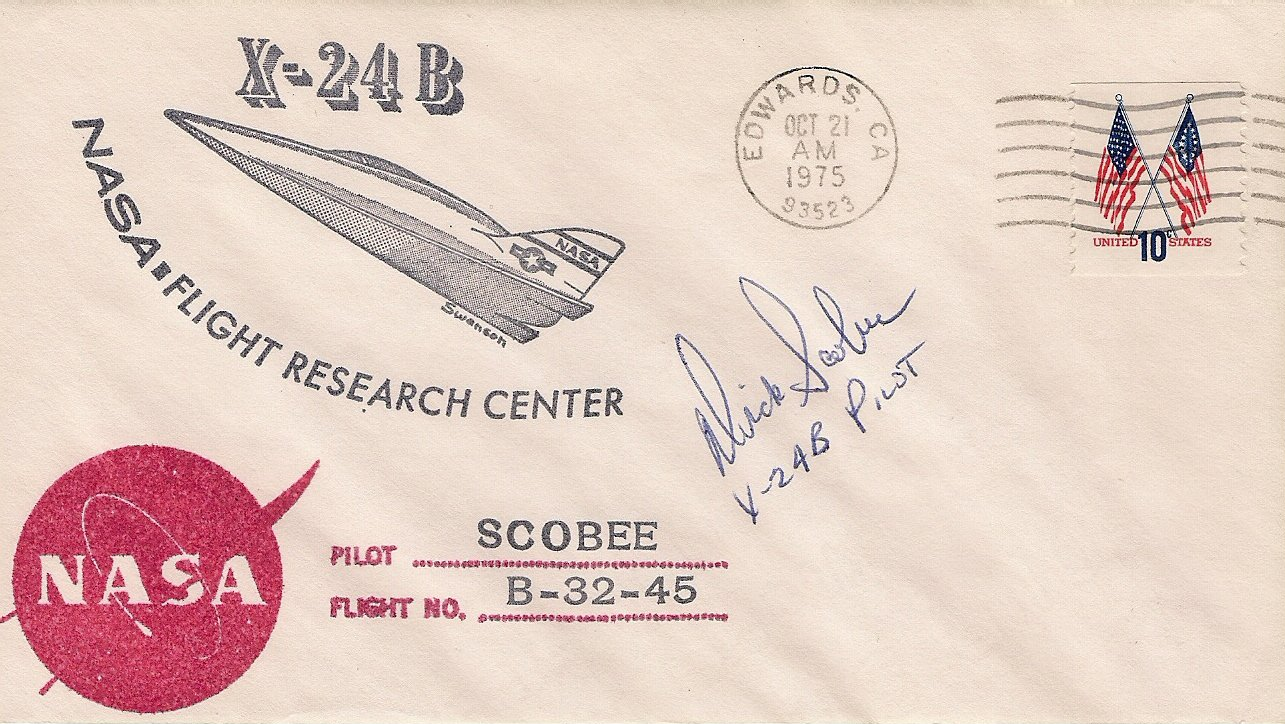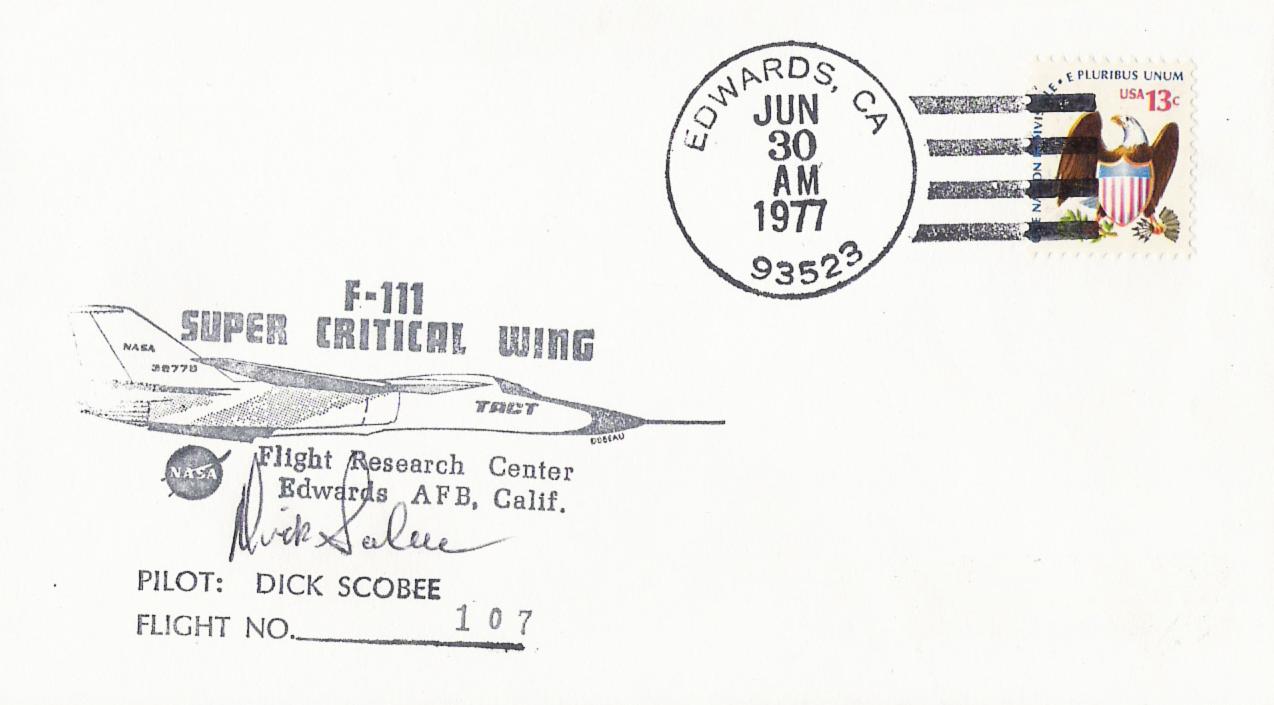Vice Admiral Forrest S. Petersen USN ret - (1922-1990)
Vice Admiral Petersen Forrest S. Petersen, was born in Holdrege, Nebraska on 16 May 1922. He was commissioned an Ensign upon graduation from the United States Naval Academy in June of 1944 and reported to the destroyer USS CAPERTON (DD 650). While serving aboard CAPERTON he participated in campaigns in the Philippines, Formosa and Okinawa. After graduation from flight training in 1947, he was assigned to Fighting Squadron Twenty Able which was later re-designated Fighter Squadron ONE NINETY TWO. He was selected for Post Graduate training in Aeronautical Engineering in July 1950 and upon completion of two years of study at the Naval Post Graduate School was awarded a Bachelors Degree (AE). He continued studies for one year at Princeton University and received a Masters Degree in Engineering. From 1953 to 1956 he served with Fighter Squadron FIFTY ONE.
In 1956 he was selected to attend the Naval Test Pilot School and remained as an instructor following graduation. In August 1958 he was assigned duties as Research Pilot in the X-15 Program and served with the National Aeronautics and Space Administration Flight Research Center at Edwards, California until January 1962. During that time he made five free flights in the X-15 and achieved a speed of 3,600 MPH (Mach No. 5.3) and an altitude of 101,800 feet. Petersen was the only Navy pilot to fly the X-15. In July 1962 he was a joint recipient of the Collier Trophy which was presented by President John F. Kennedy and the NASA Distinguished Service Medal which was presented by Vice President Lyndon B. Johnson.
Petersen served as Commanding Officer of Fighter Squadron ONE FIFTY FOUR prior to being assigned to the office of Director, Division of Naval Reactors, AEC for Nuclear Power Training. He reported to USS ENTERPRISE in January 1964 and served therein as Executive Officer until April 1966. He was awarded the Bronze Star for duty during ENTERPRISE's first combat tour in Vietnam. He was then assigned duties as an Assistant to the Director of Naval Program Planning in the office of the Chief of Naval Operations. In November 1967 he assumed command of USS BEXAR (APA 237) in the Pacific Fleet Amphibious Forces. Following an eight month deployment with the Seventh Fleet Amphibious Forces in the Western Pacific he was awarded the Navy Commendation Medal with Combat V.
Admiral Petersen was awarded the following awards for service in World War II, Korean War and the Vietnam War: Legion of Merit, Distinguished Flying Cross, Bronze Star, NASA Distinguished Service Medal, Navy Commendation Medal, American Defense, Pacific Theatre, American Theatre, Asiatic Theatre, China Service, Japanese Occupation, Philippine Liberation, Philippine Presidential Unit Citation, World War II Victory, Korean Service, United Nations Korean Service, Vietnam Service, Vietnamese Campaign. Admiral Petersen sadly passed away on December 8, 1990.
Bruce Peterson - (1933-2006)
Footage from the M2-F2 crash above
Bruce Peterson was a NASA Dryden research pilot from the early 1960s until 1967. A former US Marine Corps pilot, he joined NASA in 1960 as an aeronautical engineer. He was one of the project pilots on the Rogallo paraglider research vehicle (Parasev) program. The Parasev 1-A and 1-B evaluated the use of an inflatable, flexible wing for the recovery of manned space vehicles, with over 100 research flights made between 1962 and 1964.
On December 3, 1963 he flew the M2-F1 Lifting Body, his first of 15 flights in these wingless research vehicles. He flew the M2-F1 ten times, and made the first flight of the HL-10 on December 22, 1966. Peterson retired from research flying after his fourth flight in the M2-F2. He lost his sight in one eye as a result of a landing accident in the aircraft on May 10, 1967 (footage from the accident above via YouTube) is above. Peterson continued at NASA Dryden as the Research Project Engineer on the Digital Fly-By-Wire program of the late 1960s and early 1970s, and later assumed responsibility for Safety and Quality Assurance for Dryden. A native of Washburn, North Dakota, Peterson was born on May 23, 1933. He attended the University of California at Los Angeles, and California State Polytechnic College at San Luis Obispo. Peterson received his Bachelor of Science degree in Aeronautical Engineering from the latter in 1960. Click here to read Bruce Peterson's NASA Dryden biography. Mr Peterson sadly passed away on 1st May 2006, he was 72 years old.
MAJ. GEN. Cecil W. Powell USAF ret. - (1935-2011)
General Powell was born in 1935, in Port Arthur, Texas. He earned a bachelor of science degree in military science from the U.S. Naval Academy in 1959 and a master's degree from Auburn University in 1975. He completed the Air War College in 1975. Upon graduation from the academy he was commissioned as a second lieutenant in the Air Force. General Powell completed pilot training at Spence Air Base, Ga., and Vance Air Force Base, Okla., and received his pilot wings in July 1960. He then received advanced fighter training in F-100s, and from June 1961 to January 1964 flew F-104s at George Air Force Base, Calif. He was subsequently assigned to the 80th Tactical Fighter Squadron at Yokota Air Base, Japan. During this assignment General Powell flew 104 combat missions over Southeast Asia in F-105s.
The general completed the Air Force Test Pilot School at Edwards Air Force Base, Calif., in 1968, and remained there as a test pilot involved in a variety of test programs, including the F-4E (slats), F-15 and made 3 flights each in the Martin Marietta X-24A and Northrop M2-F3 "lifting body" research vehicles.
In August 1973 General Powell became executive officer to the commander of 7th Air Force and the U.S. Support Activity at Nakhon Phanom Royal Thai Air Force Base, Thailand. After graduating from the Air War College in July 1975, he transferred to Nellis Air Force Base, Nev., where he served initially as the ACEVAL-AIMVAL test planner, then as commander of the 422nd Fighter Weapons Squadron (operational test). From August 1977 to January 1980 the general served as director of fighter and reconnaissance requirements at Headquarters Tactical Air Command, Langley Air Force Base, Va. He then became commander of the 363rd Tactical Fighter Wing at Shaw Air Force Base, S.C. From January 1982 to May 1983 General Powell served as assistant director for operational initiatives and joint matters in the Directorate of Operations, Headquarters U.S. Air Force, Washington, D.C. In June 1983 he transferred to Headquarters U.S. Air Forces in Europe as inspector general and later served as assistant deputy chief of staff for operations.
In June 1985 he became the first commander of the 316th Air Division and commander of the Kaiserslautern Military Community. The general was assigned as deputy commander for research, development and acquisition, Armament Division, Eglin Air Force Base, Fla., in July 1986. He assumed his present duties in June 1987. The general is a command pilot with more than 4,000 flying hours. His military decorations and awards include the Distinguished Service Medal, Legion of Merit, Distinguished Flying Cross, Meritorious Service Medal and Air Medal with four oak leaf clusters. General Powell retired from the USAF on February 1st, 1990 and sadly passed away on 1st August 2011. I was fortunate to correspond with General Powell and honored to receive the below email from him on 21st July 2006:
Mr. Horne,
I'm honored to be included in your collection of test pilot memorabilia.
Your pics are on their way back to you - inscribed as requested.
At last count I had flown 43 different types and models of aircraft during
my career. Some were one flight wonders like the Swedish Draaken and French
Mirage - but, I guess those still count.
My favorite was (and still is) the Lockheed F-104 Starfighter. Perhaps
because it was my first operational aircraft, and presented the first chance
I had to really fly on my own after pilot training. Plus the idea of
something that could go faster than Mach 2 and only had 7foot wings was most
appealing.
Didn't dislike any of the aircraft I flew. The most challenging to fly
precisely (for me anyway) were the early versions of the McDonnell F-4
Phantom. The control system was very sensitive and I tended to overcontrol
the airplane. Probably just my ineptness being demonstrated. The F-4 evolved
through several versions in the Air Force, and I flew them all. It turned
out to be one of the most versatile of our fighters.
Hope you enjoy the materials I returned. Best of luck. Stay well and stay
safe.
Cecil (Cec) Powell
M/G (Ret), USAF
Lifting Body Test Pilot
Colonel Jackie L. "Jack" Ridley USAF - (1915-1957)
Colonel Jack Ridley was born on June 16th, 1915 in Garvin, Oklahoma. In school, the young Oklahoman had a natural taste for mathematics and even in early life he showed an unmistakable aptitude for studying and analysing the way that machines worked. Following high school, he entered the ROTC. program at the University of Oklahoma where he received his bachelor of science degree in mechanical engineering in 1939. The world into which he graduated was uncertain, at best. Europe was a field of battle once again; Hitler’s blitzkrieg on Poland was about to teach the world a new concept of war, and England and France were to declare war on Germany before the end of the year. By the summer of 1941, the Battle of Britain had been fought and the United States was desperately building up its long-neglected armed forces to prepare for the world conflict which many thought was inevitable. In July of that year, the young engineer received a commission in the U.S. Army field artillery and began a military career which would continue for the rest of his life. The science of flight soon attracted him, however, and it was not long before he transferred to the Army Air Forces. Lieutenant Ridley was sent to the Flying Training School at Kelly Army Air Base in Texas, where he earned his pilot wings in May 1942.
The Air Corps had great need for engineering-trained pilots and, instead of being sent into an operational combat unit, Ridley was ordered to the Consolidated Vultee plant in Fort Worth, Texas, where his initial assignment was to conduct acceptance tests on four-engined B-24 Liberator bombers. Soon thereafter, he was named as engineering liaison officer on both the B-24 and B-32 programs. Even at that early date, the Air Corps was developing the mighty six-engined B-36 intercontinental bomber, later to become the mainstay of the post-war Strategic Air Command, and Ridley found himself assigned to that program as well.
Two years later, after the tide of battle had turned to the Allies favour, Ridley was sent off to add education to his experience. The technological revolution spawned by the war had demonstrated that the post-war Air Forces success would be dependent upon having a corps of officers with first-rate technical training. After attending the Army Air Forces School of Engineering at Wright Field (later renamed the Air Force Institute of Technology), Ridley was sent to the California Institute of Technology, in Pasadena, California where he received his Master of Science degree in aeronautical engineering in July 1945.
With the war virtually over, the young officer was sent to Wright Field, Ohio, and assigned to the Air Materiel Command’s Flight Test Division. The conflict just ending had seen the greatest advances in the history of aeronautics: the piston engine reached its peak of development, jet propulsion was overturning all previous concepts of airplane design, and planes were flying higher and faster than ever before. The scientific and engineering staff at Wright Field had played a pivotal role in all of these developments and, clearly, this was the supreme location for an ambitious young would-be engineering test pilot. The science of training test pilots had been advancing as well, however, and before he could be put to work Ridley had to go through the Air Materiel Command Flight Performance School. In the spring of 1946, he graduated with Class 46A.
The long years of preparation would soon pay off handsomely. Even as Ridley was attending the Flight Performance School, the revolutionary X-1 rocket research airplane was making its initial unpowered check flights and, within a year, the AAF (soon to achieve independence as the United States Air Force) would assume control of the supersonic research program. Colonel Albert Boyd, the legendary chief of the Flight Test Division and his deputy Colonel Fred J. Ascani had the critical responsibility for selecting the project team that would attempt the world’s first supersonic flight.
In the spring of 1947, Boyd & Ascani appraised the roster of 125 test pilots and finally selected three volunteers who were considered very junior in terms of their flight test experience: Capt. Charles E. "Chuck" Yeager, 1st Lt. Robert A. "Bob" Hoover, and Ridley. Yeager and Hoover were named as primary and backup pilot respectively, and Ridley as project engineer. Boyd realized that Ridley's laid back demeanour and Oklahoma drawl masked a highly disciplined, razor sharp mind and he believed that, with his test piloting experience and his unique ability to translate esoteric concepts into everyday terms, he would be able to provide Yeager and Hoover with all of the engineering expertise they would need.
Ridley's task was to analyse all of the technical data that was generated during the X-1 flights as it proceeded toward the unexplored region of supersonic flight. Studying the phenomena which the research plane encountered as it passed through the transonic region, he translated all of the information into pilot terminology for Yeager so that the flight program could be carried forward expeditiously, yet with safety.
For all of his technical accomplishments during the high speed research program, however, the youthful-appearing engineer is most fondly remembered by the team for improvising a vital piece of equipment at the last minute. Two days before taking the X-1 on its first supersonic flight, Chuck Yeager broke two ribs in a horseback riding accident. With the aid of an understanding civilian doctor, he was able to conceal his condition from everyone but Ridley. Without the full use of his right arm, however, it would be impossible to seal himself into the tiny X-1 cockpit. With great common sense, Ridley quietly provided a length of broom handle which saved the day. Using the leverage provided by the broom handle, Yeager closed the hatch without difficulty. The rest, they say is history!
Still youthful, Ridley was promoted to full colonel in 1956 and became a member of the U.S. Military Assistance Advisory Group. Then, flying as a passenger in a C-47 over Japan on March 12, 1957, Col. Ridley died at the age of 42 when the transport crashed into a snow-covered mountainside northwest of Tokyo.
In 1980, the Ridley Mission Control Center at Edwards Air Force Base was dedicated in Jack Ridley’s honor.
Major General Robert A. Rushworth USAF - (1924-1993)
General Rushworth received his pilot wings in September 1944 and is a combat veteran of WWII flying in the China-Burma-India theatre of operations, where he flew the Douglas C-47 Skytrain. General Rushworth was released from active duty in 1946 and was recalled in 1951 to the 49th Fighter-Interceptor Squadron at Dow AFB, Maine flying the F-80C.
In July 1956, General Rushworth was sent to the US Air Force Experimental Flight Test Pilot School graduating in January 1957. As a test pilot at Edwards AFB, General Rushworth flew the following; F-101, F-102, F-104, F-105, F-106 and many other jet fighter aircraft. General Rushworth is perhaps best known as pilot of the X-15 experimental research airplane, flying the X-15 for a record 34 times. General Rushworth (on his 14th flight) made the third “astro” flight on June 27, 1963 when he flew the X-15 to an altitude of 285000ft or 53.9 miles. The maximum speed attained on any of General Rushworth’s flights was during his 17th flight on December 5, 1963 when a speed of 4017mph or Mach 6.08. He is rated a command pilot astronaut and has more than 6,500 flying hours in more than 50 different aircraft.
His military decorations and awards include the Legion of Merit with oak leaf cluster, Distinguished Flying Cross with two oak leaf clusters, Meritorious Service Medal, Air Medal with 10 oak leaf clusters and Air Force Commendation Medal. He also wears the National Aeronautical and Space Administration Exceptional Service Medal. General Rushworth retired from the USAF on June 1, 1981. Sadly General Rushworth passed away on March 18, 1993, he was 68. For General Rushworth's full Air Force biography click here.
Louis W. "Lou" Schalk - (1926-2002)
Louis W. "Lou" Schalk is best known for piloting the first flight of the Lockheed A-12, first of the Blackbird family of Mach 3.0+ aircraft and for his work as chief test pilot for Lockheed Advanced Development Company. He began and ended his flight test career with the same philosophy. He would fly every aircraft he could get into. After Schalk graduated from the United States Air Force Test Pilot School in 1954, he was assigned to Fighter Operations at Edwards Air Force Base, where his teachers included Chuck Yeager and Pete Everest.
He was a USAF test pilot from 1954 to 1957. After completing the Phase II tests on the Lockheed F-104 Starfighter, Schalk left the Air Force to join Lockheed Aircraft as a test pilot. In 1959, he joined the Lockheed Advanced Development Company "Skunk Works" and became its chief test pilot. He played a major role in the design of the cockpit of the A-12, YF-12 and SR-71 Blackbird and then flew the first thirteen flights on the A-12, beginning in 1962. He made the first four Blackbird flights exceeding Mach 3.0, with a top speed of Mach 3.287 (2,287 miles per hour). Much of this flight testing was performed at altitudes as high as 90,000 feet. Schalk performed over 100 hours of flight test on the Lockheed Electra, America's first turbo-prop commercial airliner, conducting structural integrity tests. He also tested the performance and stability of the North American F-86H Sabre and the stability and systems on the McDonnel F-101A Voodoo. A 1954 graduate of the USAF Test Pilot School, Schalk has flown over 5,000 hours in 70 different aircraft including the Lockheed Electra, A-11, F-104, F-86, YF-12, F-100, F-101, F-102, RAF Hunter and Javelin Aircraft.
Schalk has been honored with the Society of Experimental Test Pilots' Iven C. Kincheloe Award in 1964, was named an Eagle by the Flight Test Historical Foundation in 1996 and was selected for the Aerospace Walk of Honor. Lou Schalk was born May 29, 1926 in Alden, Iowa. He graduated from the United States Military Academy at West Point in 1948 with a Bachelor of Science degree in Military Arts and Engineering. Schalk's advice to test pilots of the future is to follow his own philosophy. "Fly all the planes you are permitted to fly. You will learn from each plane and the test pilot who checks you out". Lou Schalk sadly passed away in April 2002 aged 76.
Colonel Russell E. "Russ" Schleeh USAF - (1919-2012)
Colonel Russell E. Schleeh tested nearly every bomber from America's war-winning B-17 Flying Fortress to its strategic workhorse, the B-52 Stratofortress, during his 20 years in the United States Air Force. Schleeh learned to fly in 1940 under the Civilian Pilot Training Program while working as an apprentice aircraft mechanic. As an aviation cadet in 1941, he sought fighters, but found his niche in bombers.
A 1947 graduate of the Air Materiel Command Flight Performance School, Schleeh was the Chief of Bomber and of Fighter Flight Test at Wright Field, Ohio. He also tested in-flight refuelling systems, including rigid tow, two B-29s nose to tail, probe and drogue with the B-47, B-36 and KC-97 and the flying boom with the B-47, B-52, KC-97 and KC-135. He led the 4017th B-52 Combat Crew Training Squadron, preparing the Strategic Air Command's B-52 and KC-135 crews, and was Director of Safety, 15th Air Force, for 5 years.
When the YB-49 Flying Wing crashed, killing Captain Glen Edwards, Schleeh took over the testing program. Later, during a high-speed taxi test, the YB-49's nose gear collapsed and the unorthodox bomber broke apart and burst into flames. His own back broken, Schleeh, in disgust, suggested to the fire chief that he "let it burn."
He ultimately flew over 8,000 hours in more than 30 different aircraft including the B-17, B-24, A-20, YB-49, B-45, B-47, F-86, P-51, Spitfire, XB-28, XB-19, XB-36, XP-58, XP-87 and Me109. Retiring from the Air Force in 1962, he joined Douglas Aircraft Company as Deputy Directory of Military Marketing. Colonel Schleeh sadly passed away on 6th May 2012, he was 93 years old.
Russ Schleeh was one of the finest ever Hydroplane racer's and raced between 1955 and 1963. Read this wonderful tribute to him from the H1 Unlimited Hydroplane website.
Francis R. "Dick" Scobee - (1939-1986)
Born on May 19th, 1939, in Cle Elum, Washington. Dick Scobee enlisted in the United States Air Force in 1957, trained as a reciprocating engine mechanic, and was subsequently stationed at Kelly Air Force Base, Texas. While there, he attended night school and acquired 2 years of college credit which led to his selection for the Airman's Education and Commissioning Program. He graduated from the University of Arizona with a bachelor of science degree in Aerospace Engineering. He received his commission in 1965 and, after receiving his wings in 1966, completed a number of assignments including a combat tour in Vietnam.
He returned to the United States and attended the USAF Aerospace Research Pilot School at Edwards Air Force Base, California. Since graduating in 1972, he has participated in test programs for which he has flown such varied aircraft as the Boeing 747, the X-24B, the transonic aircraft technology (TACT) F-lll, and the C-5.
Scobee was selected as an astronaut candidate by NASA in January 1978. In August 1979, he completed a one year training and evaluation period, making him eligible for assignment as a pilot on future Space Shuttle flight crews. In addition to astronaut duties, Mr. Scobee is an Instructor Pilot on the NASA Boeing 747 Shuttle carrier airplane. He flew as pilot of STS-41C which launched from Kennedy Space Center, Florida, on April 6, 1984. Crewmembers included spacecraft commander, Captain Robert L. Crippen, and three mission specialists, Mr. Terry J. Hart, Dr. George D. "Pinky" Nelson, and Dr. James D. A. "Ox" van Hoften. During this mission the crew successfully deployed the Long Duration Exposure Facility (LDEF); retrieved the ailing Solar Maximum Satellite, repaired the orbiting Challenger on board, and replaced it in orbit using the robot arm called the Remote Manipulator System (RMS). The mission also included flight testing of Manned Manoeuvring Units (MMUs) in two extravehicular activities (EVAs); operation of the Cinema 360 and IMAX Camera Systems, and a Bee Hive Honeycomb Structures student experiment. Mission duration was 7 days before landing at Edwards Air Force Base, California, on April 13, 1984. With the completion of this flight, he logged a total of 168 hours in space.
Dick Scobee was spacecraft commander on STS 51-L which was launched from Kennedy Space Center, Florida, at 11:38:00 EST on January 28, 1986. The crew on board the Orbiter Challenger included the pilot, Commander M. J. Smith (USN) (pilot), three mission specialists, Dr. Ronald E. McNair, Lieutenant Colonel Ellison S. Onizuka (USAF),and Dr. Judy A. Resnik, as well as two civilian payload specialists, Mr. Gregory B. Jarvis and Mrs. S. Christa McAuliffe. The STS-51L crew were tragically killed on January 28, 1986 after Challenger exploded 1 minute 13 seconds after launch. The explosion occurred a fraction of a second after Scobee responded to CAPCOM Dick Covey with "Roger, go at throttle up" (this was the last communication from Challenger on the air-to-ground loop). Aside from the absolute tragedy of the loss of the crew it becomes even more tragic when we learned that at least some members of the crew were alive and conscious after the break up as the Personal Egress Air Packs were activated for Smith and two unidentified crew members (but not Scobee). The unbridled horror and terror those crew members were faced with must have been unimaginable.
